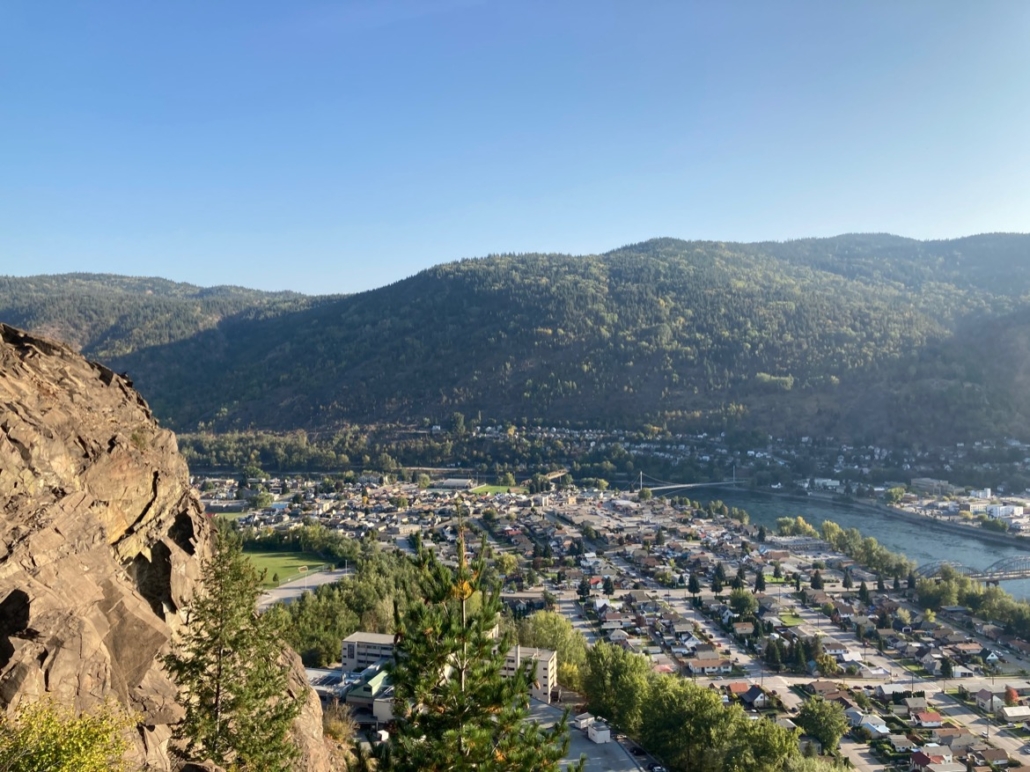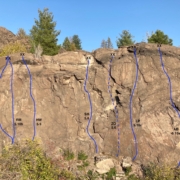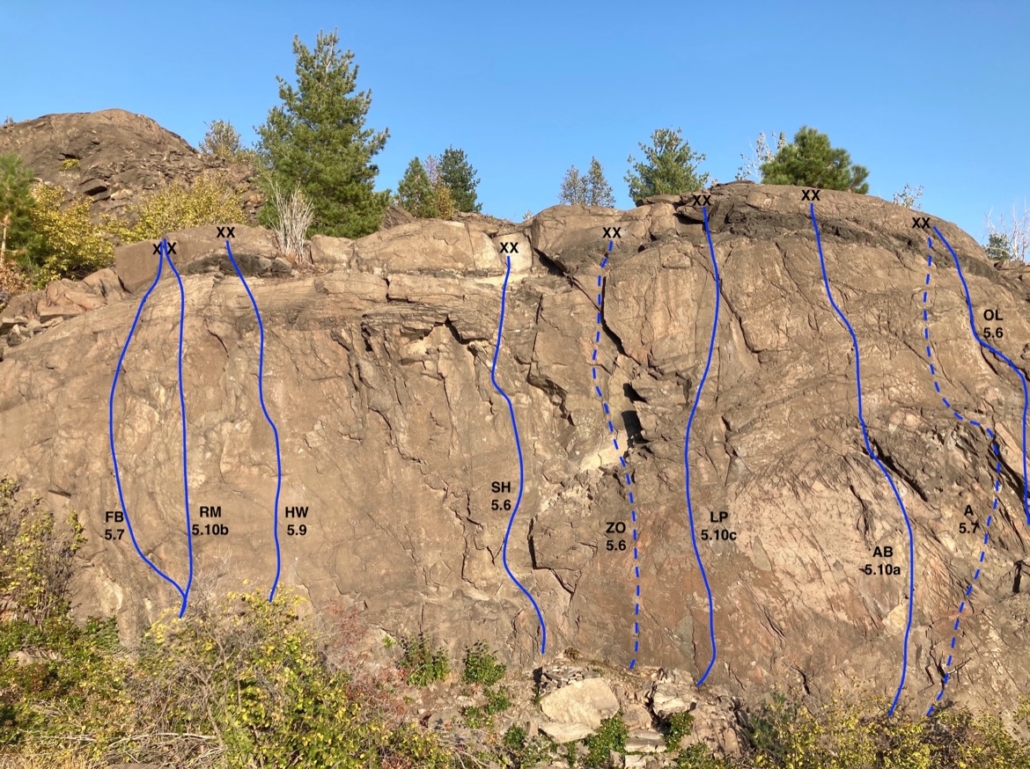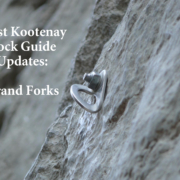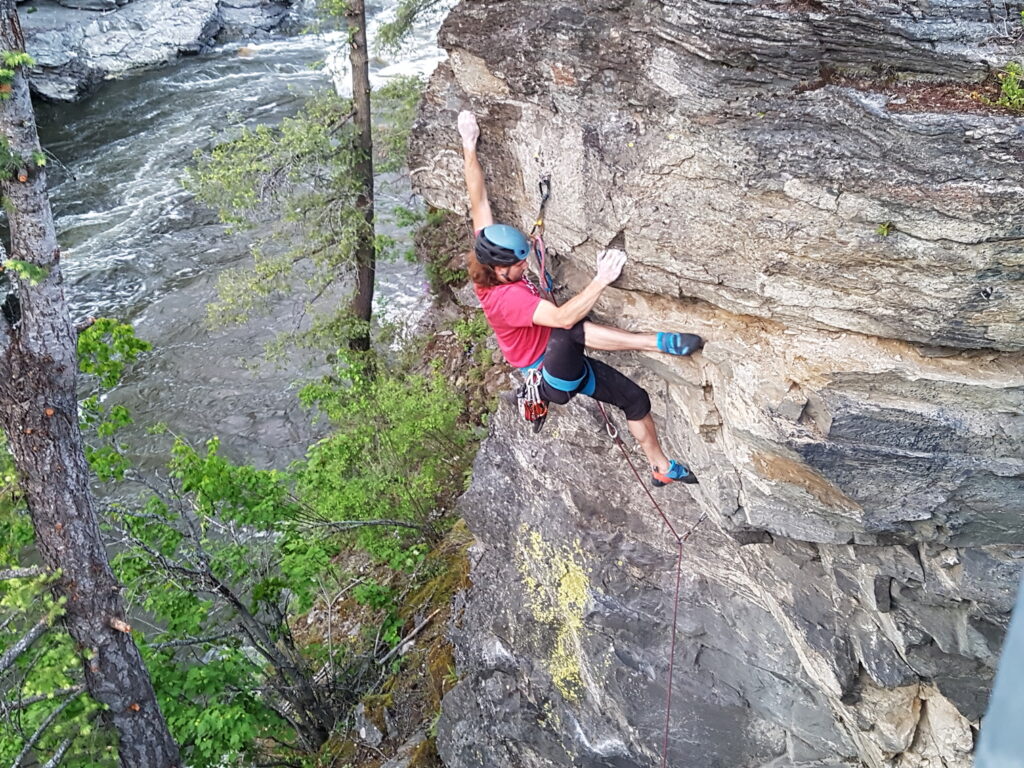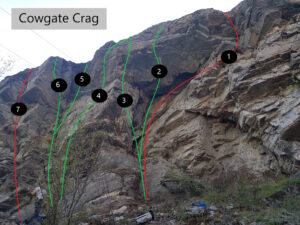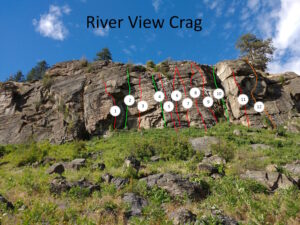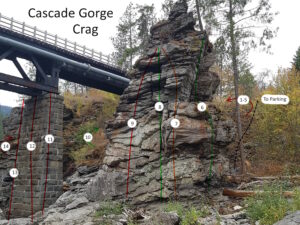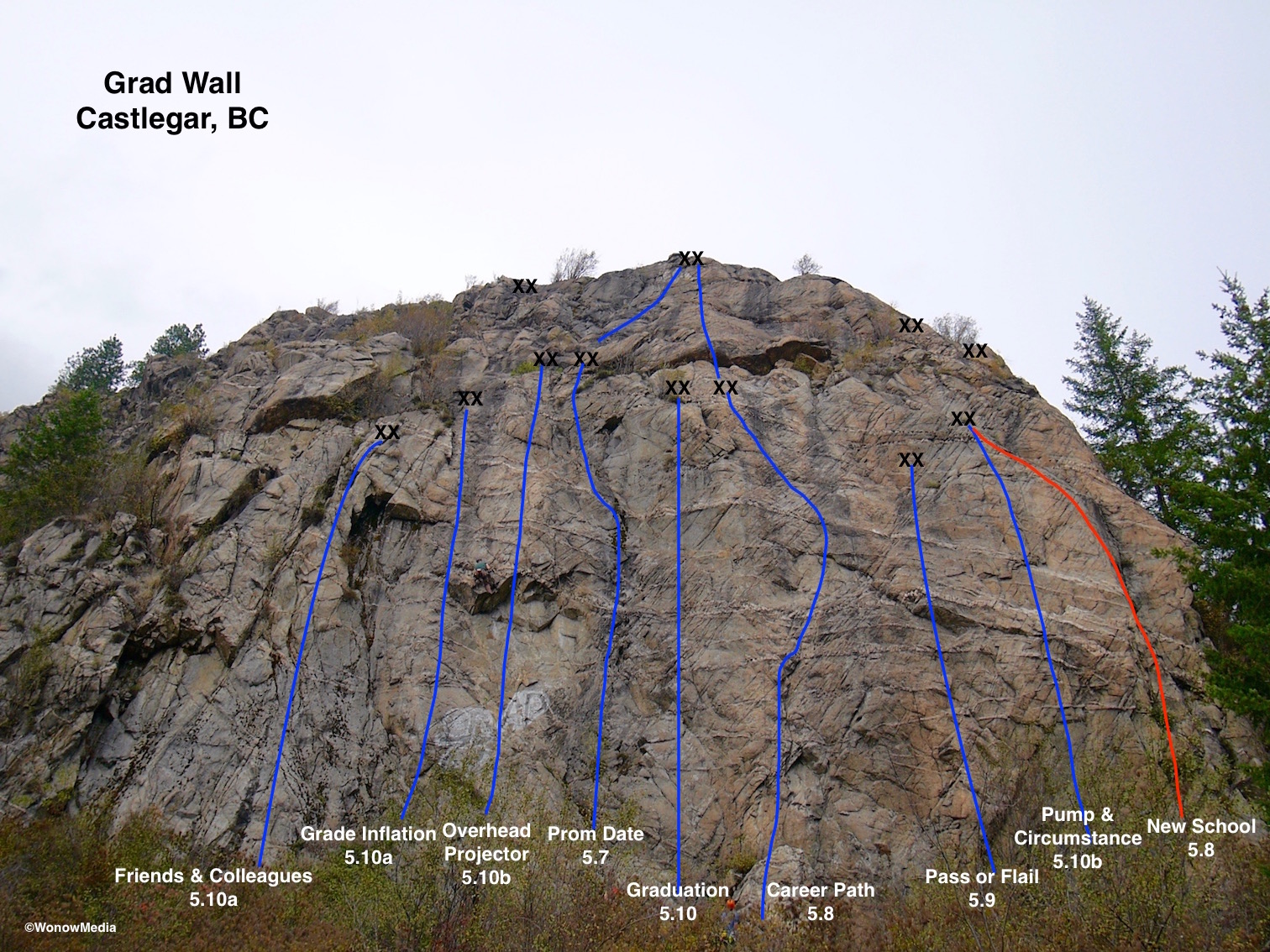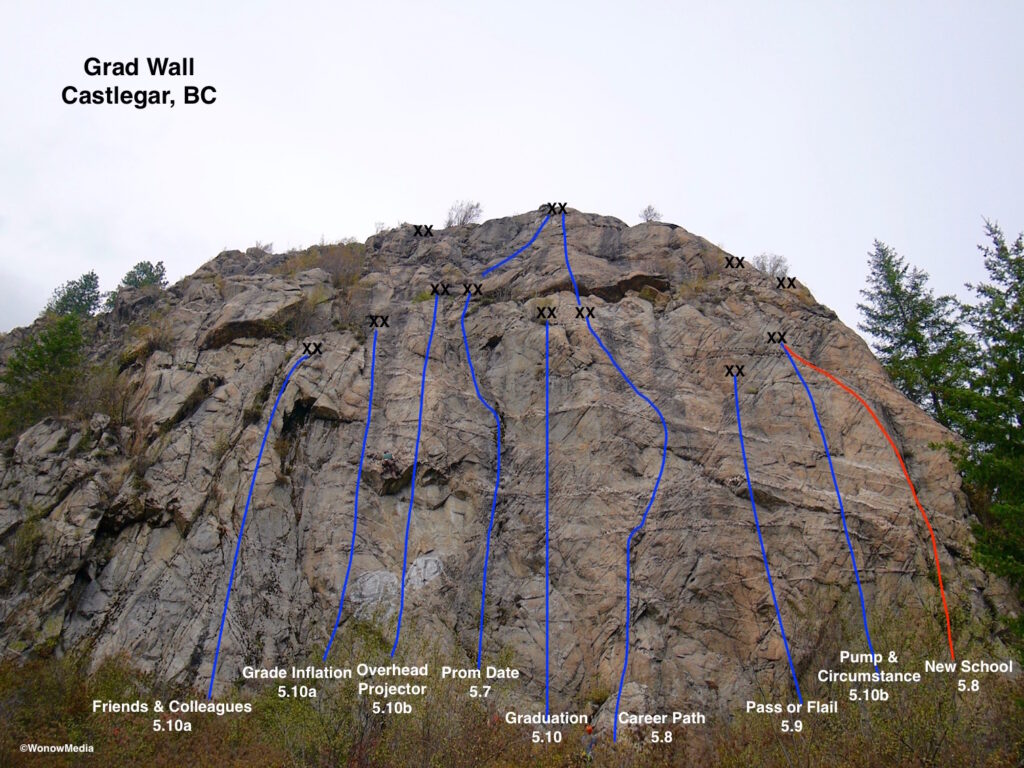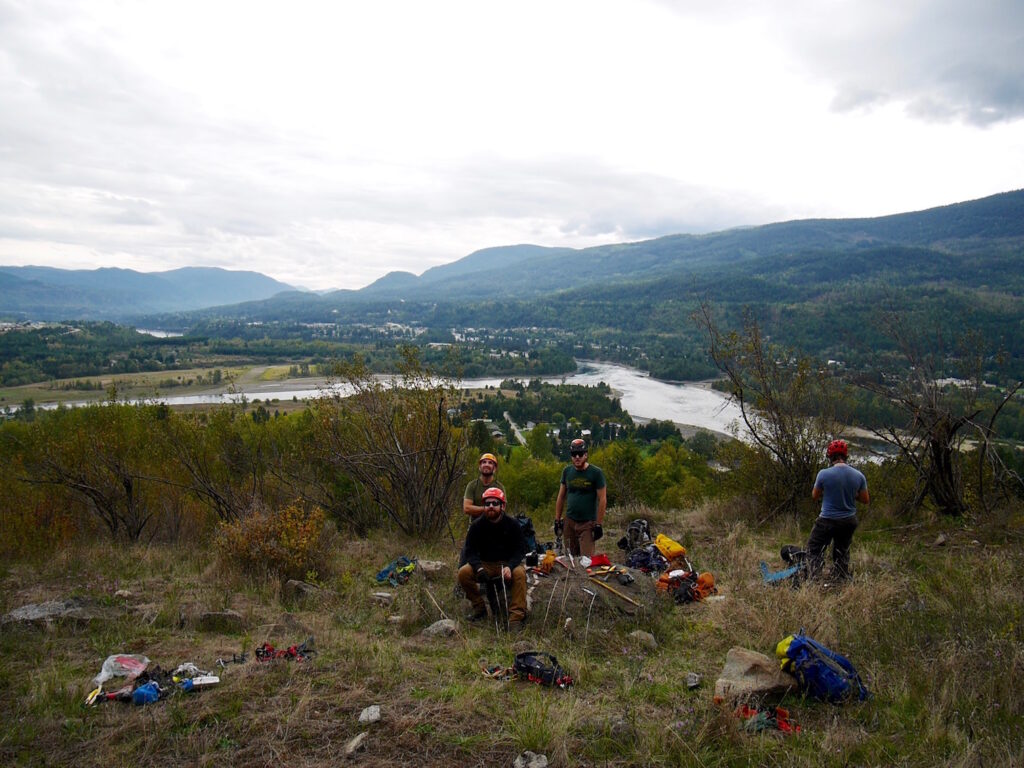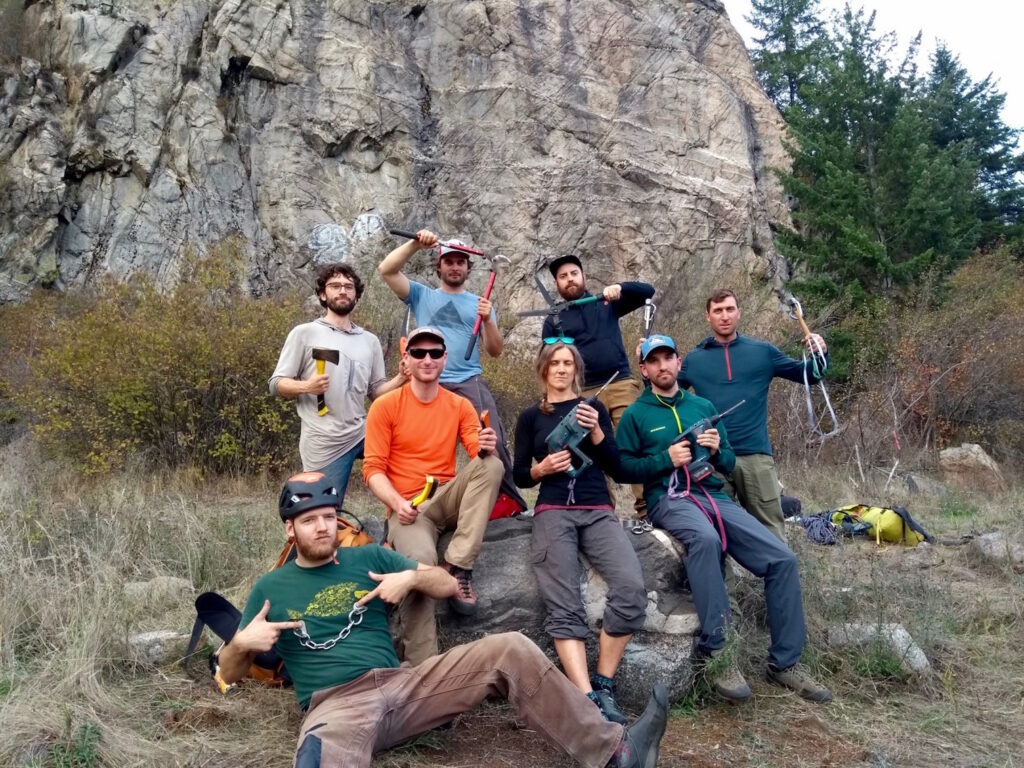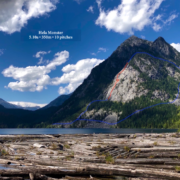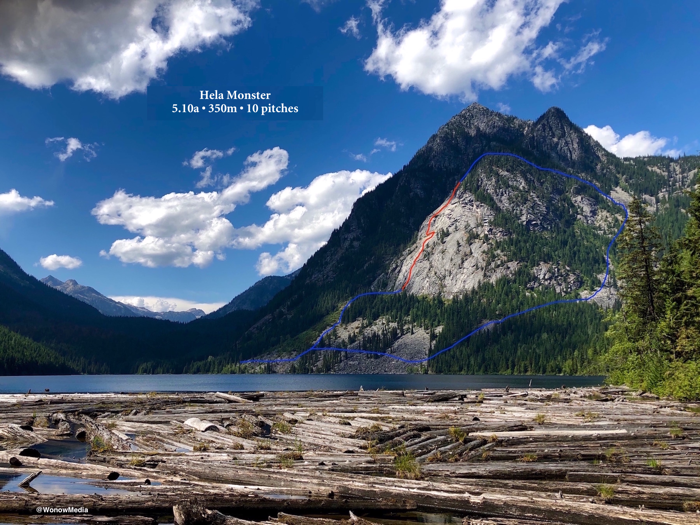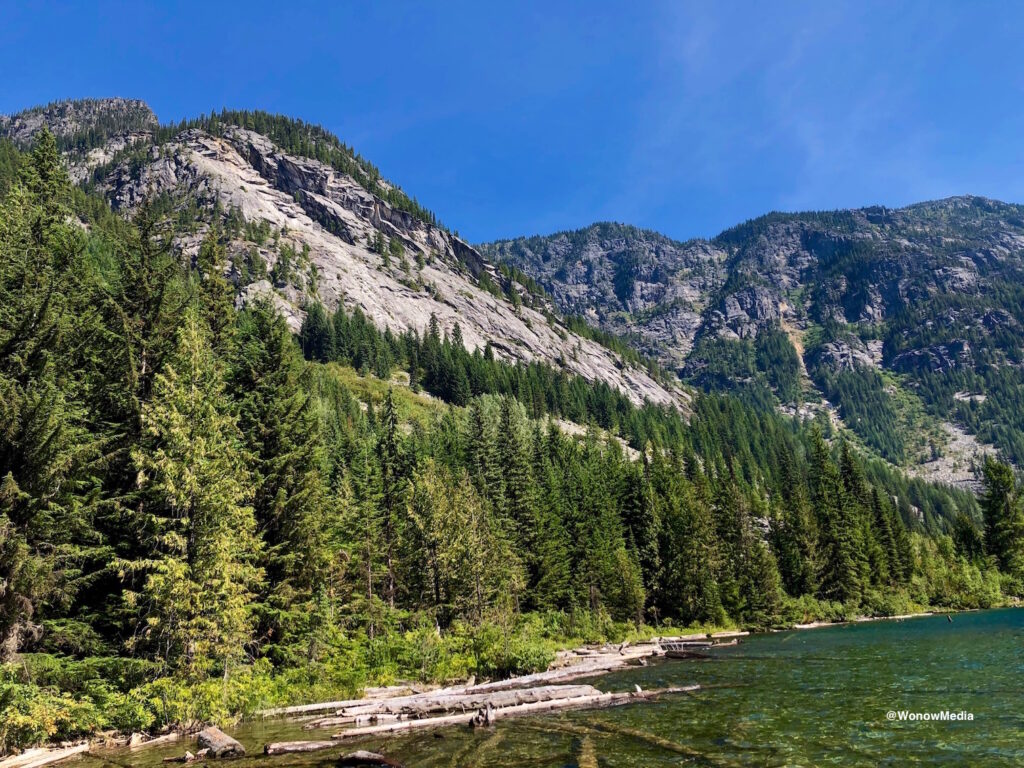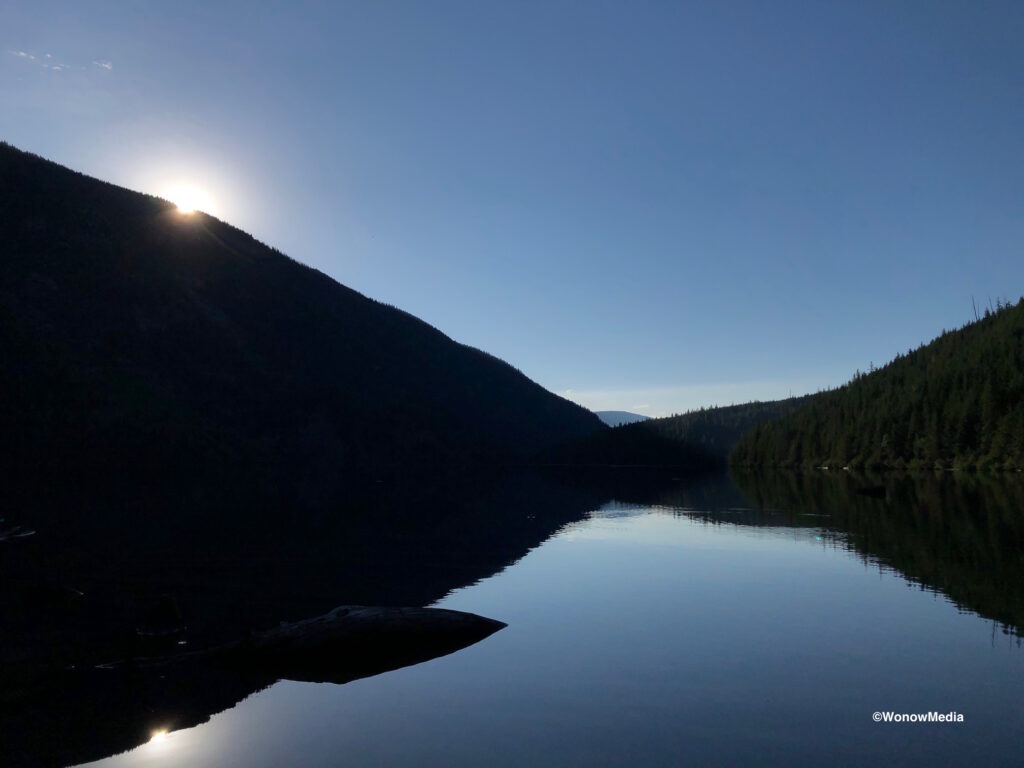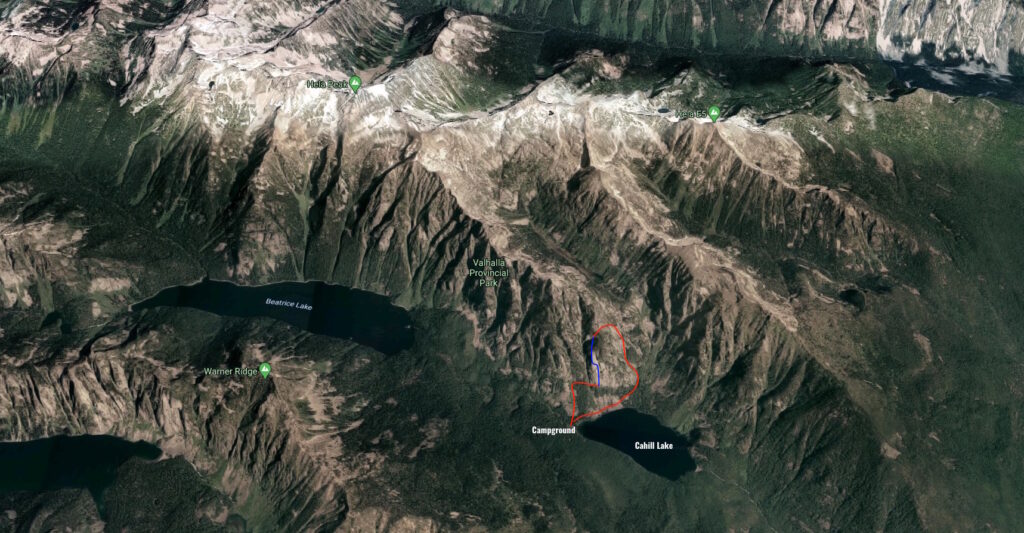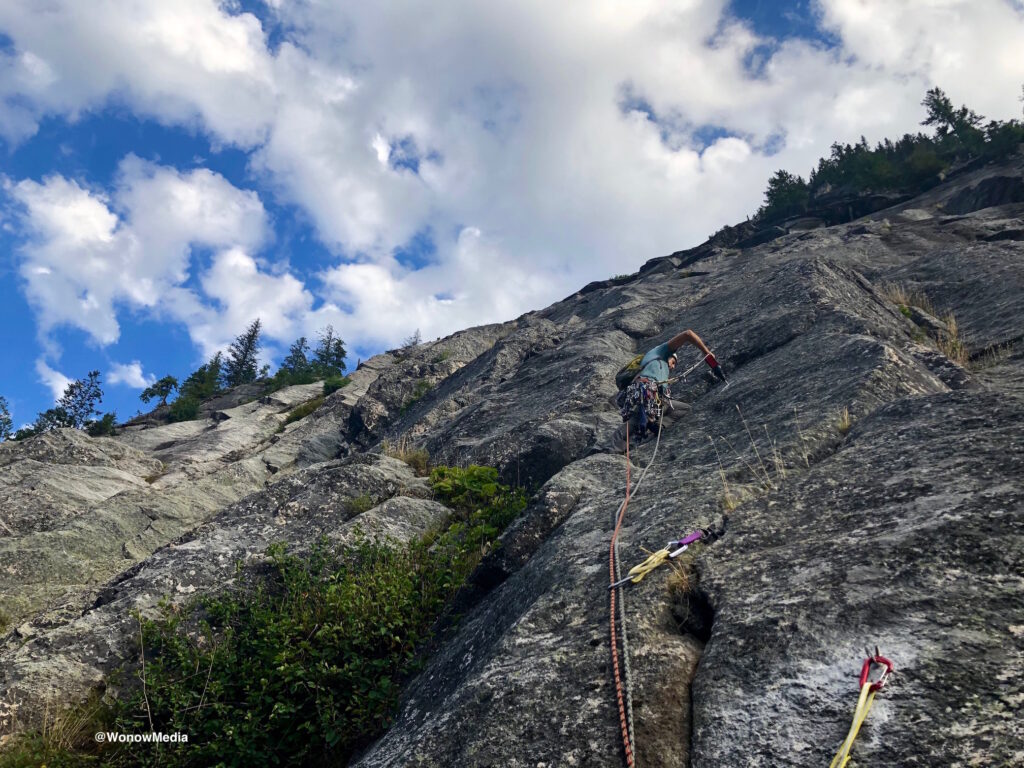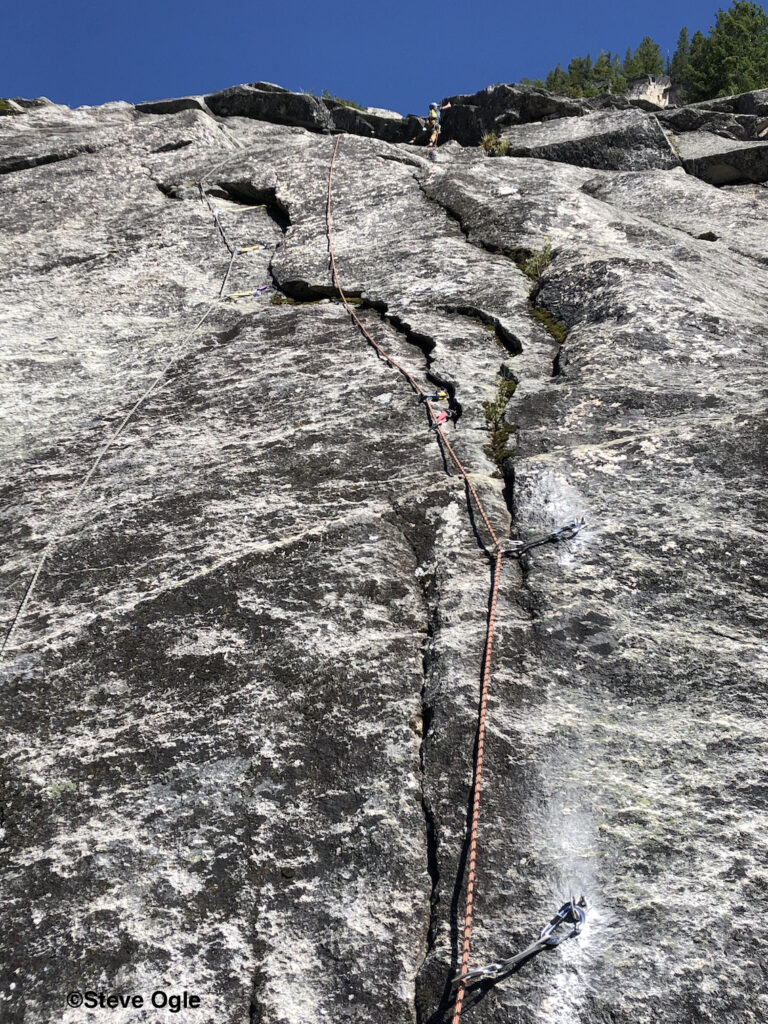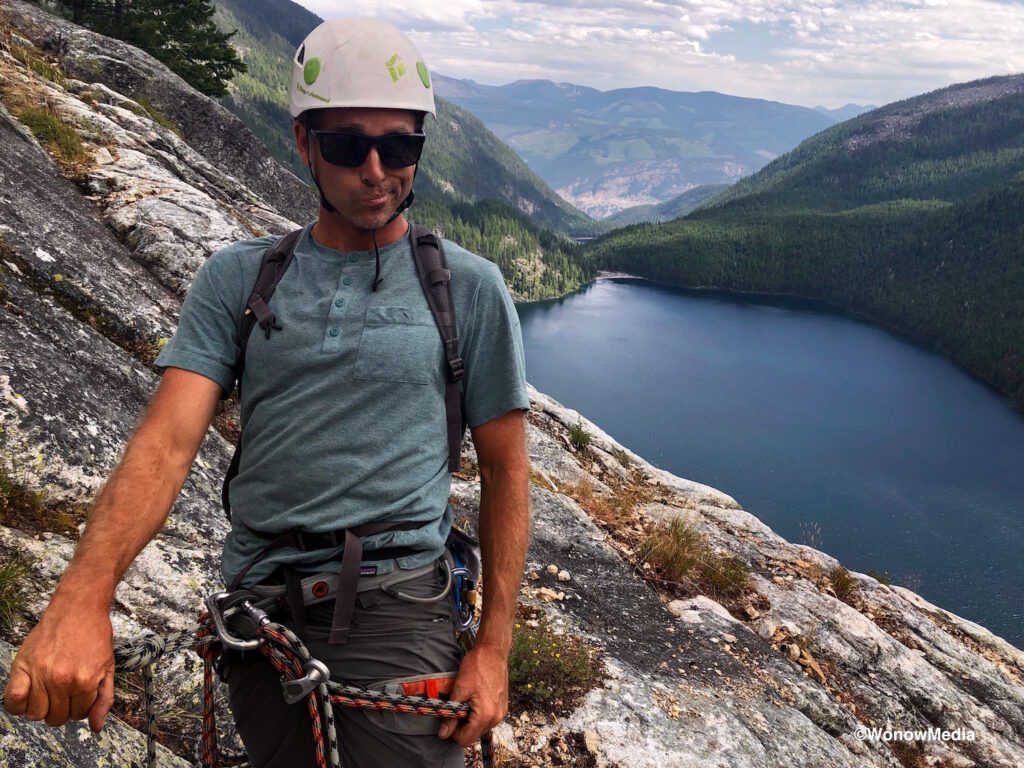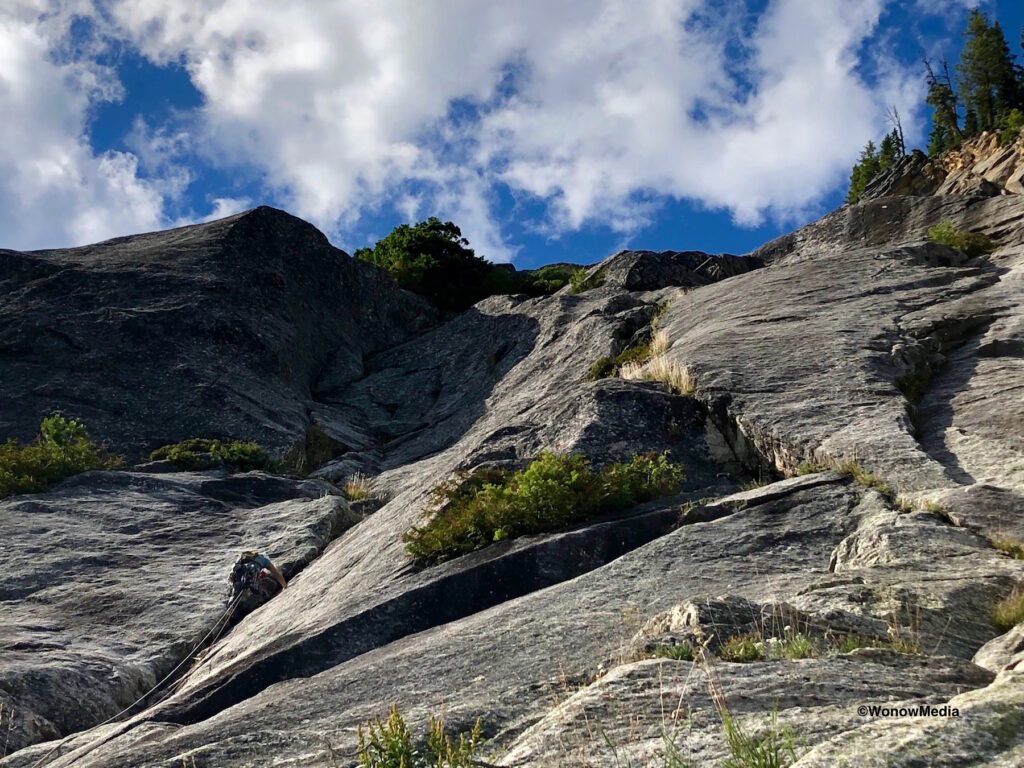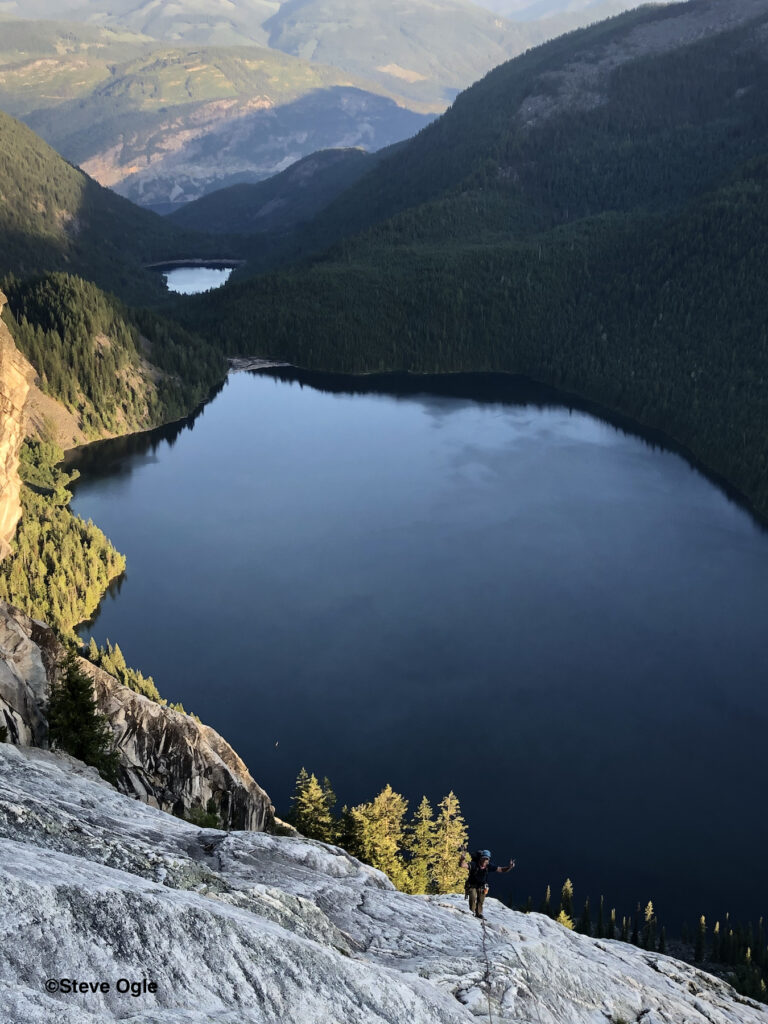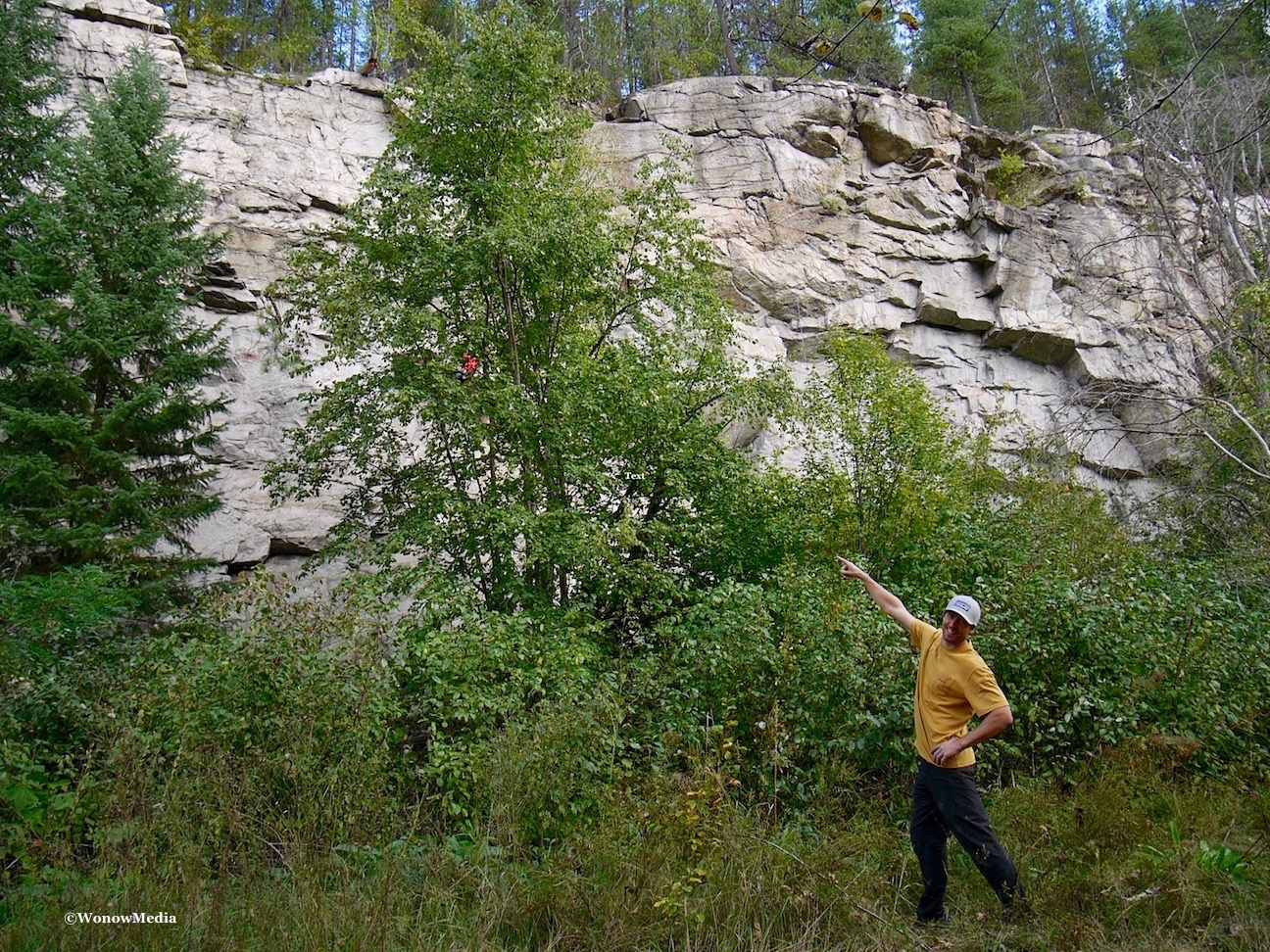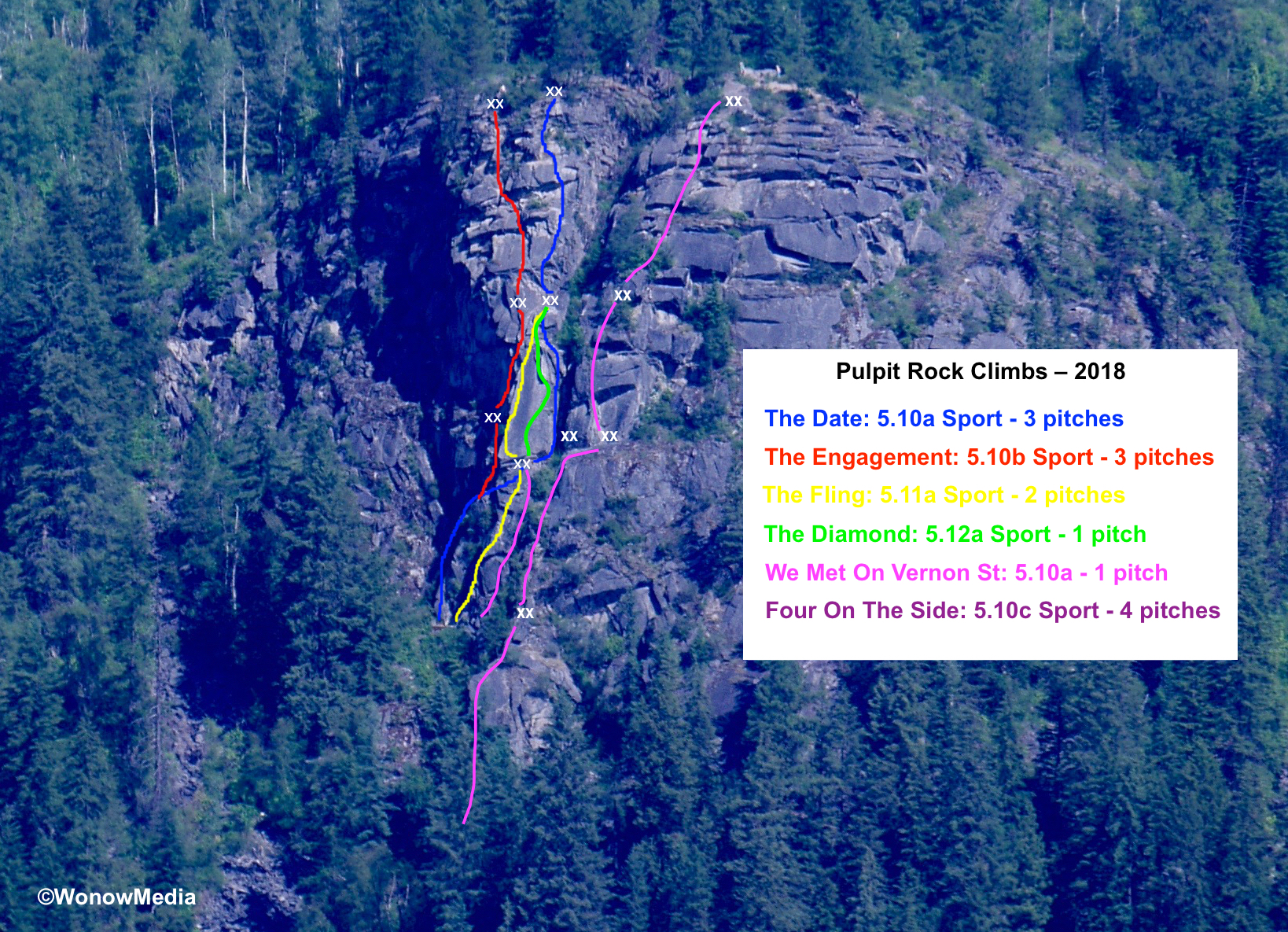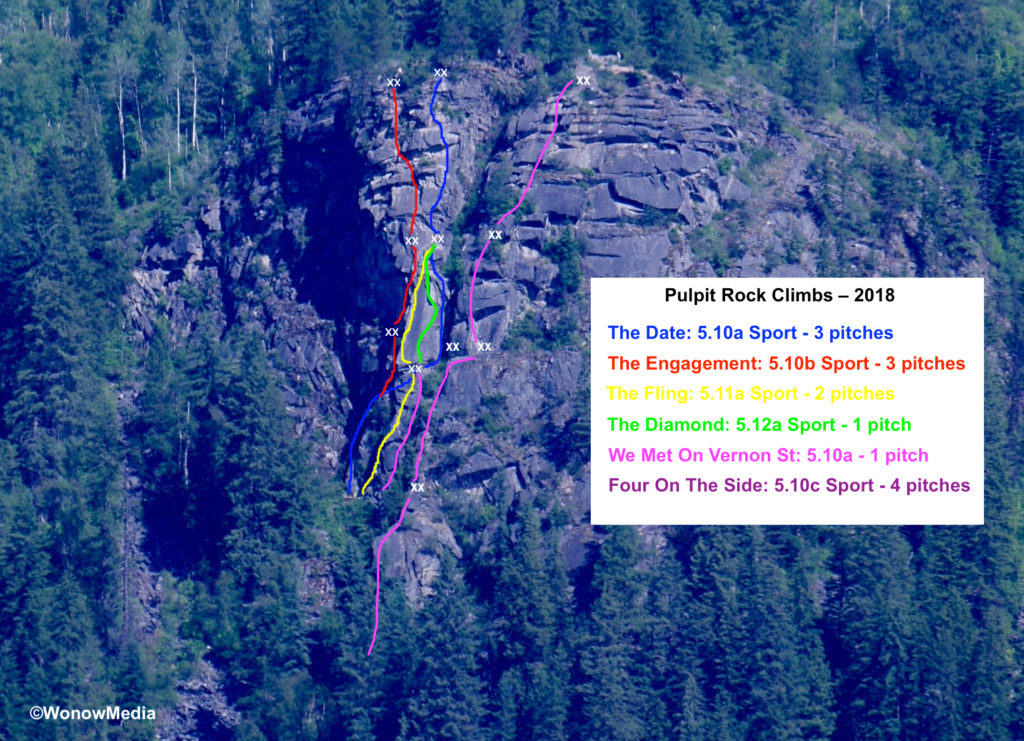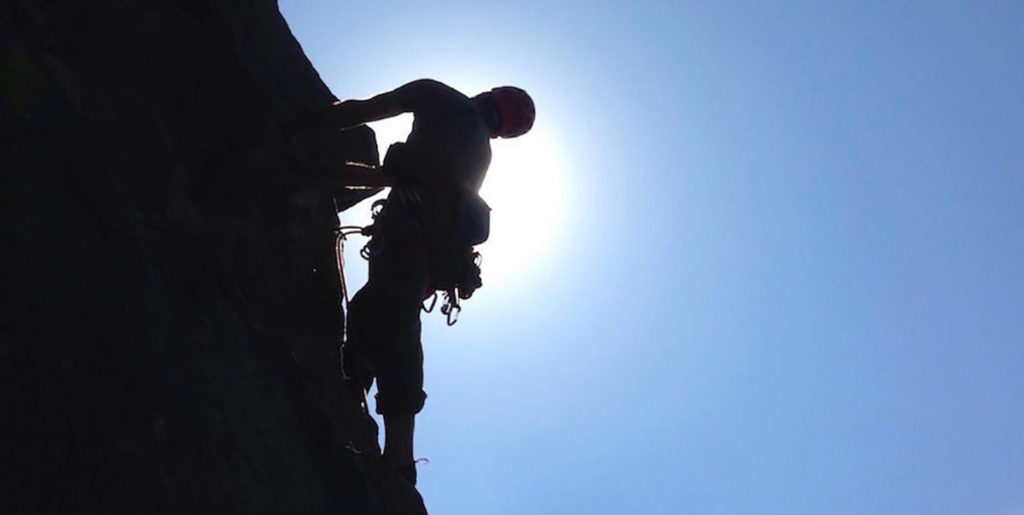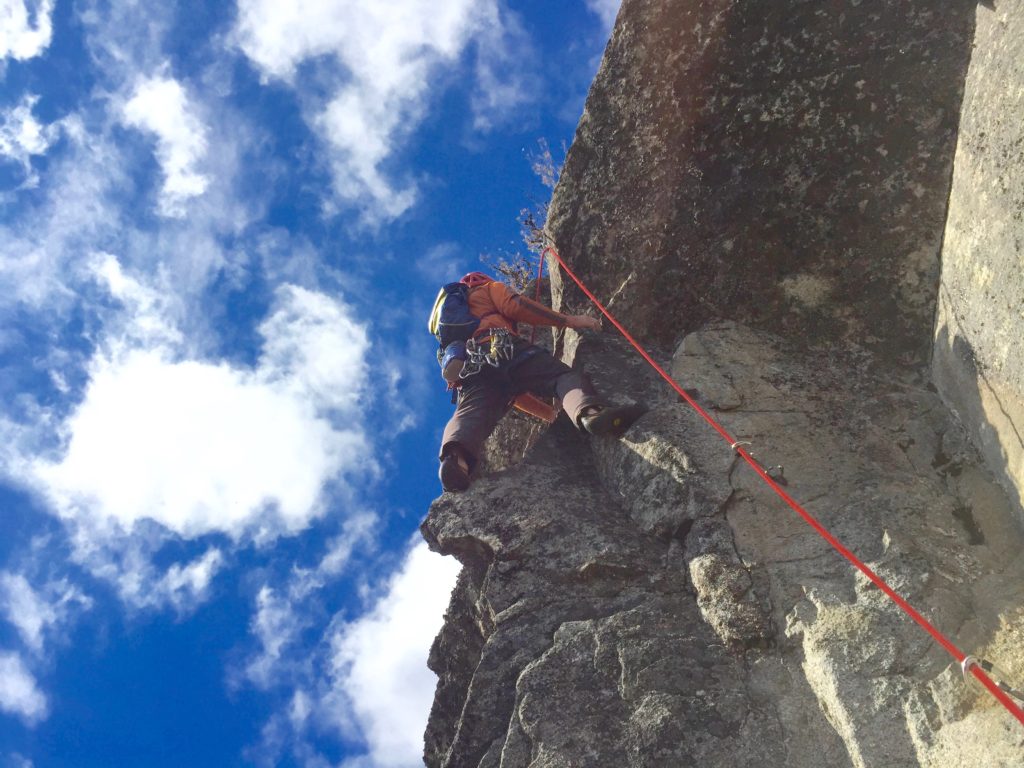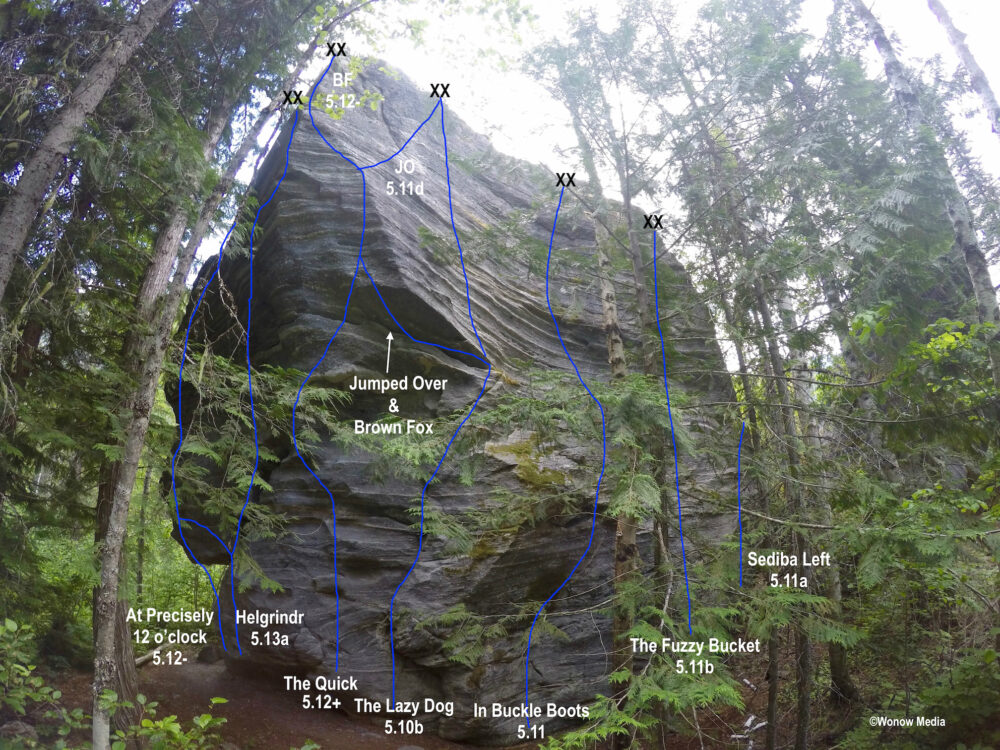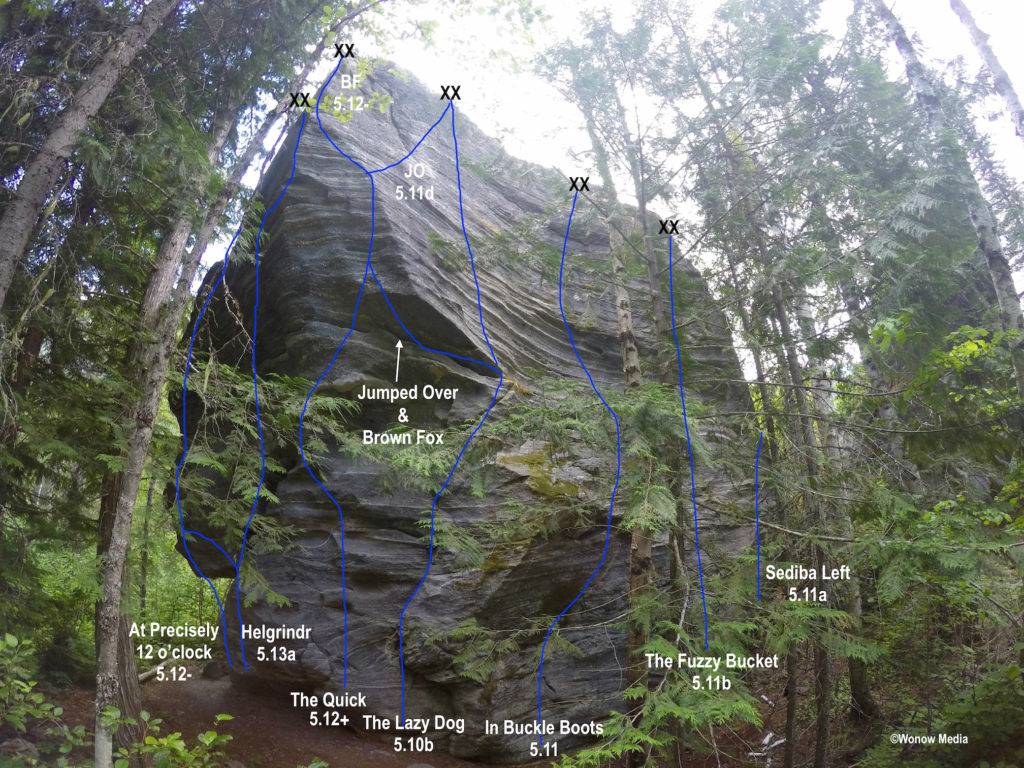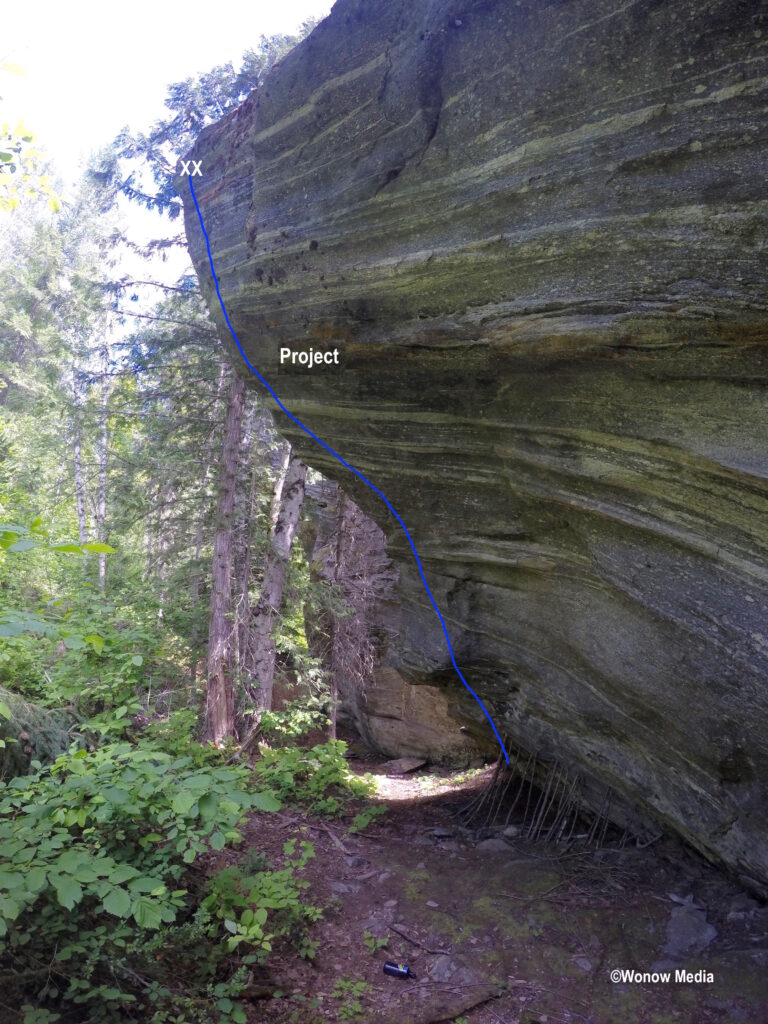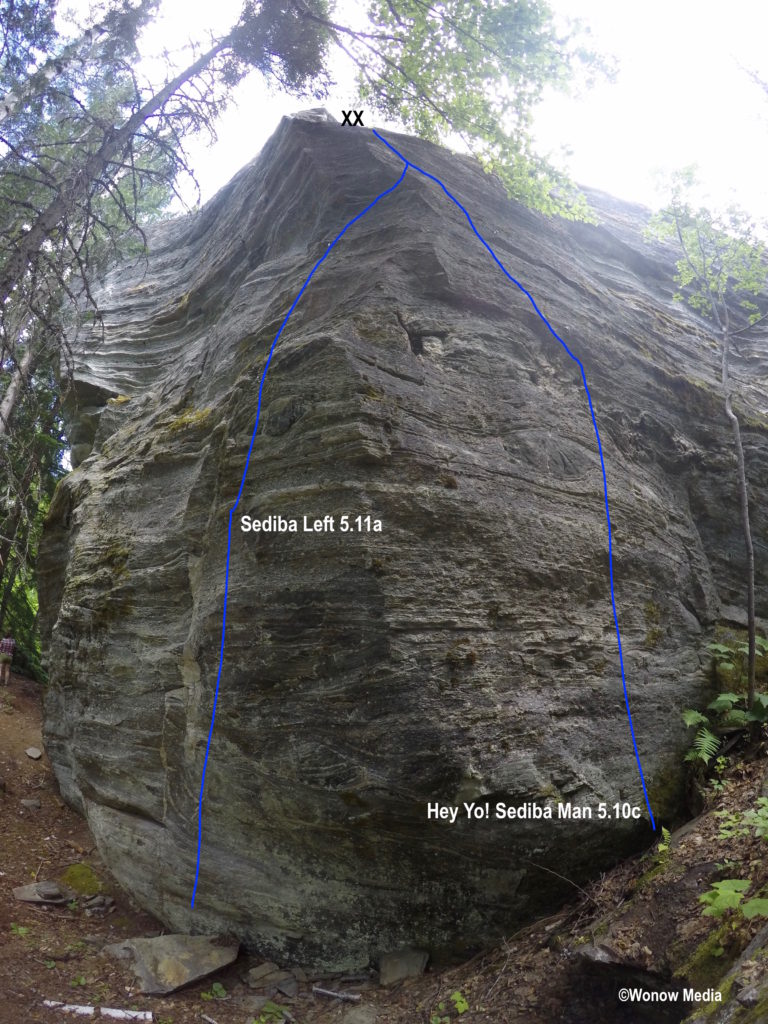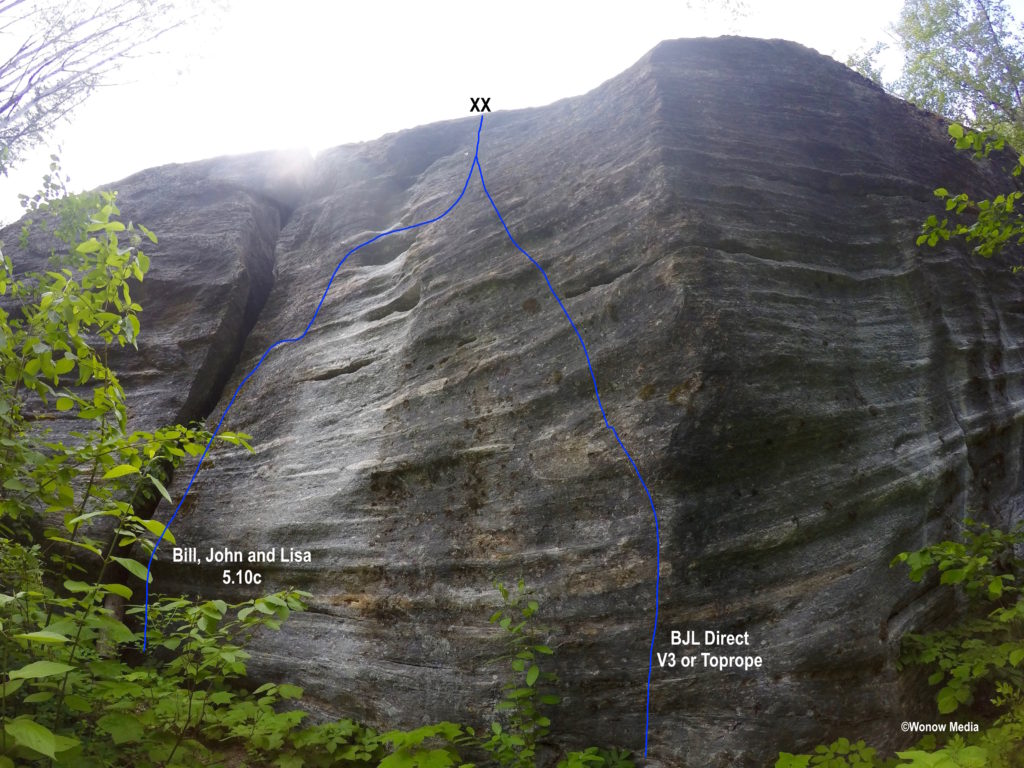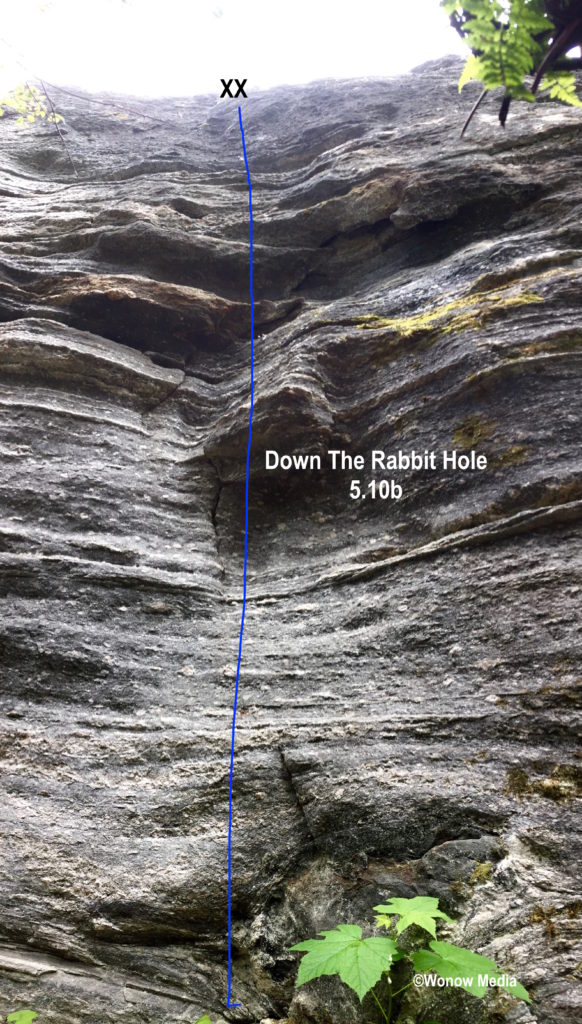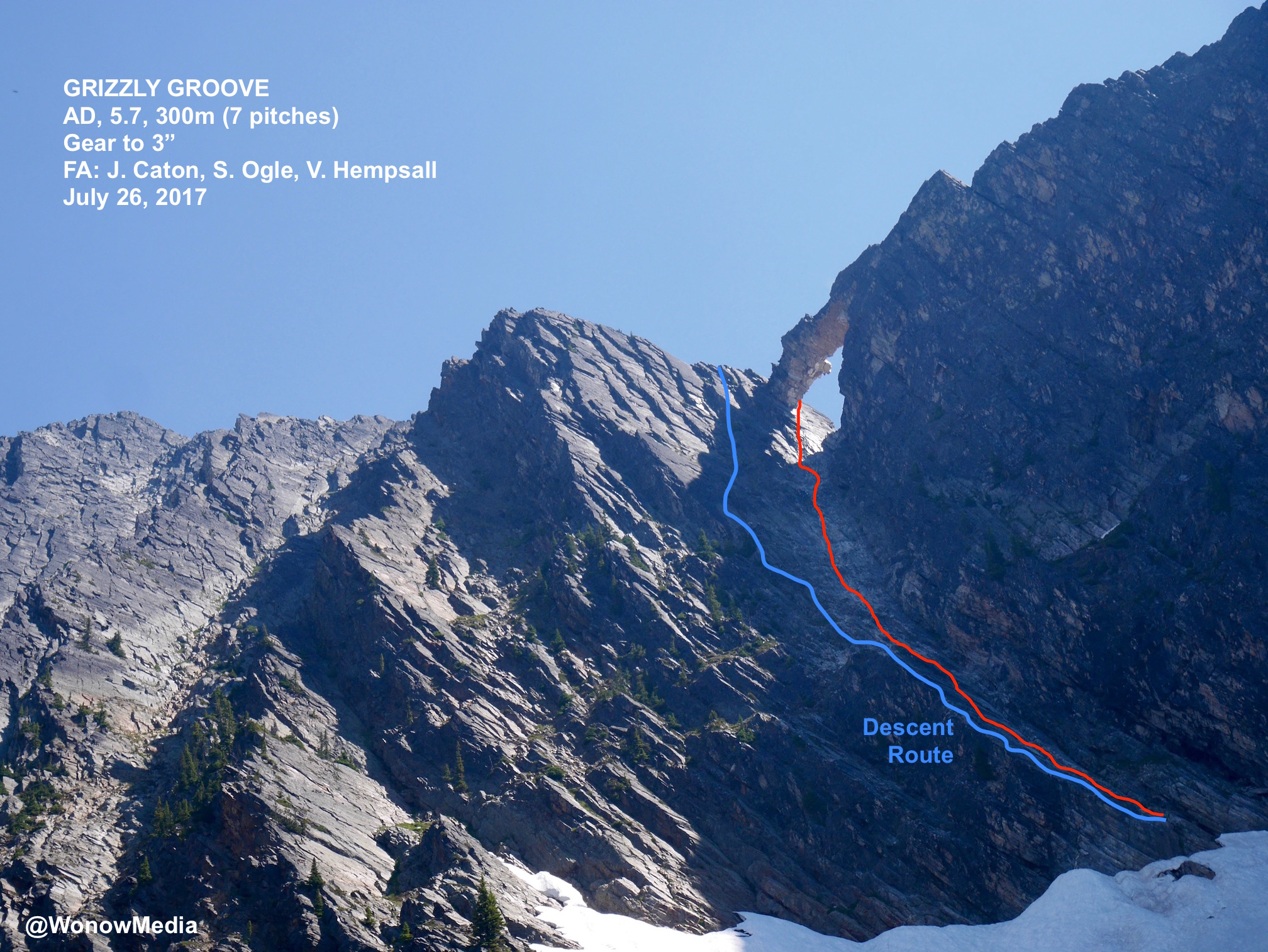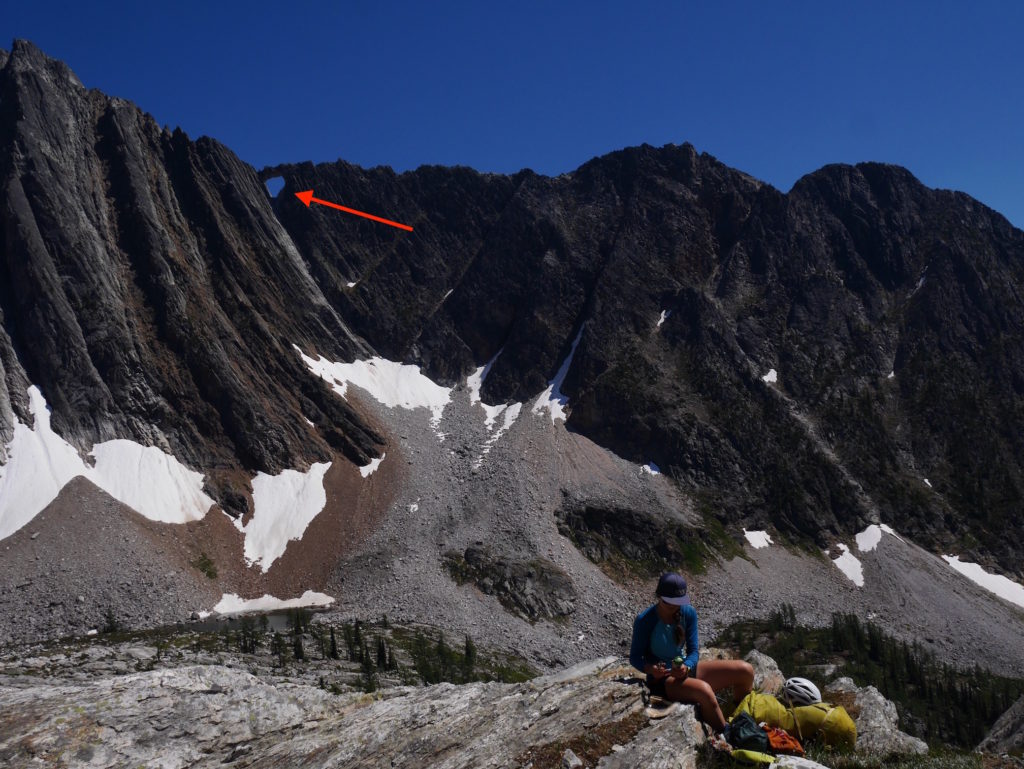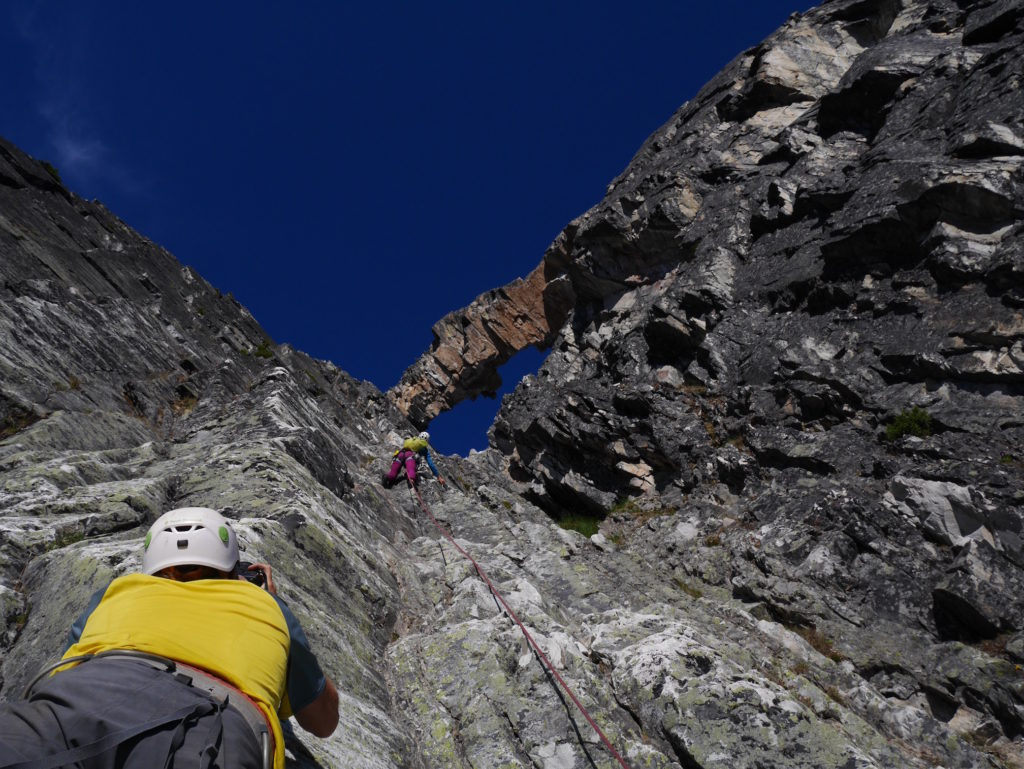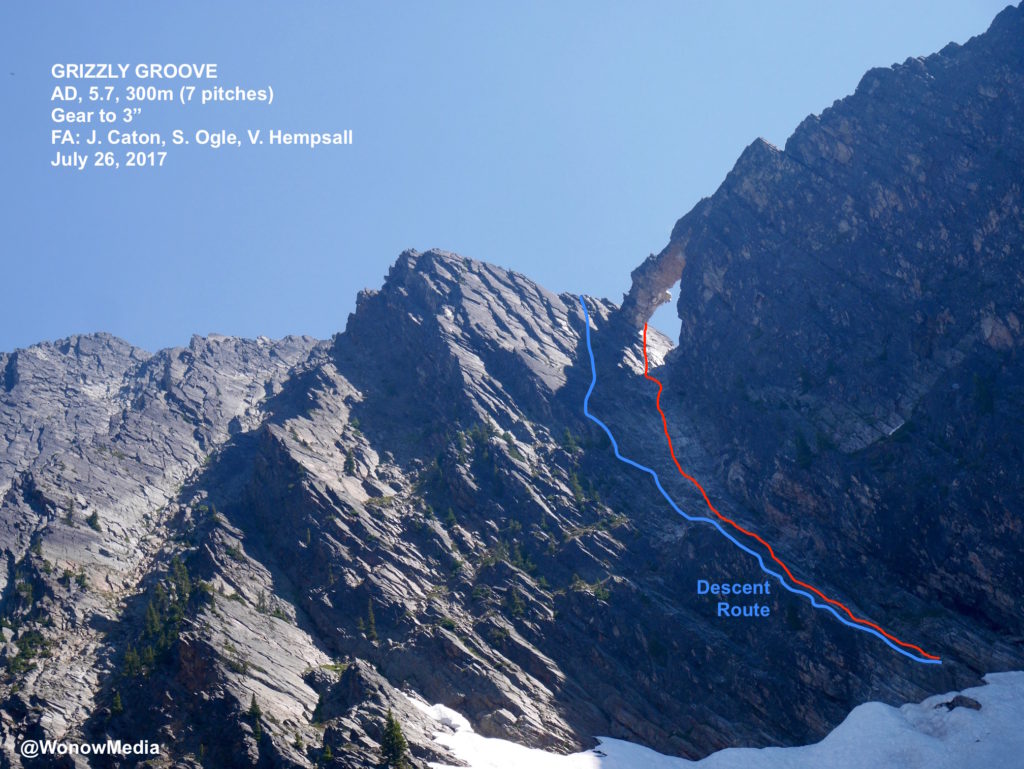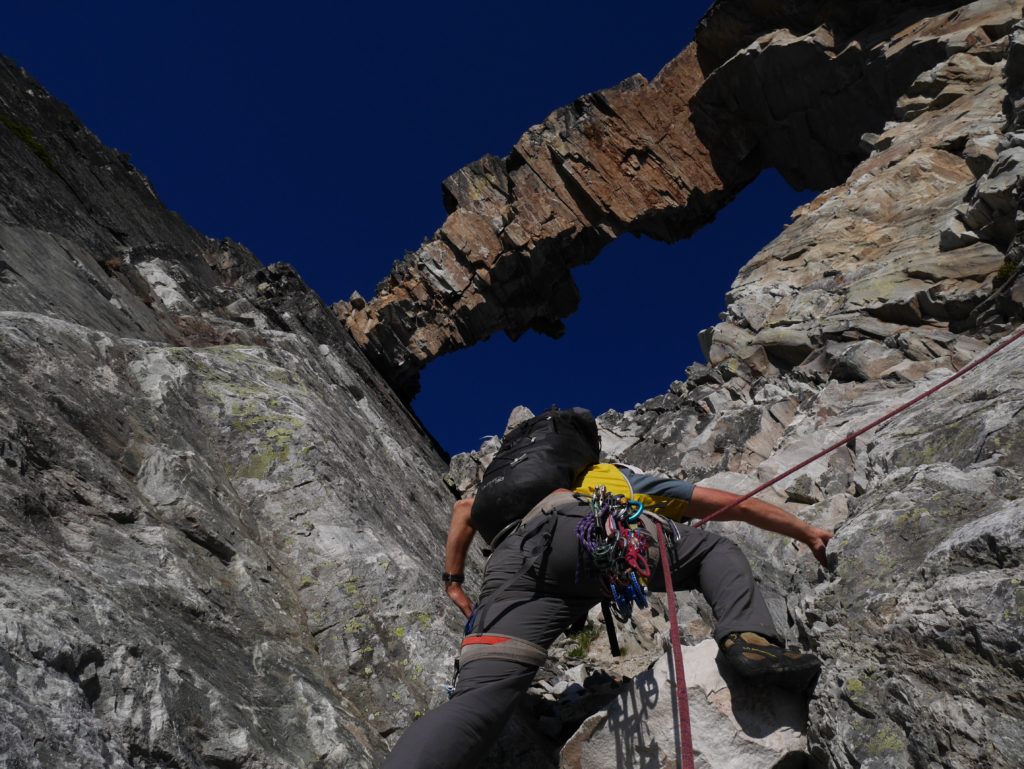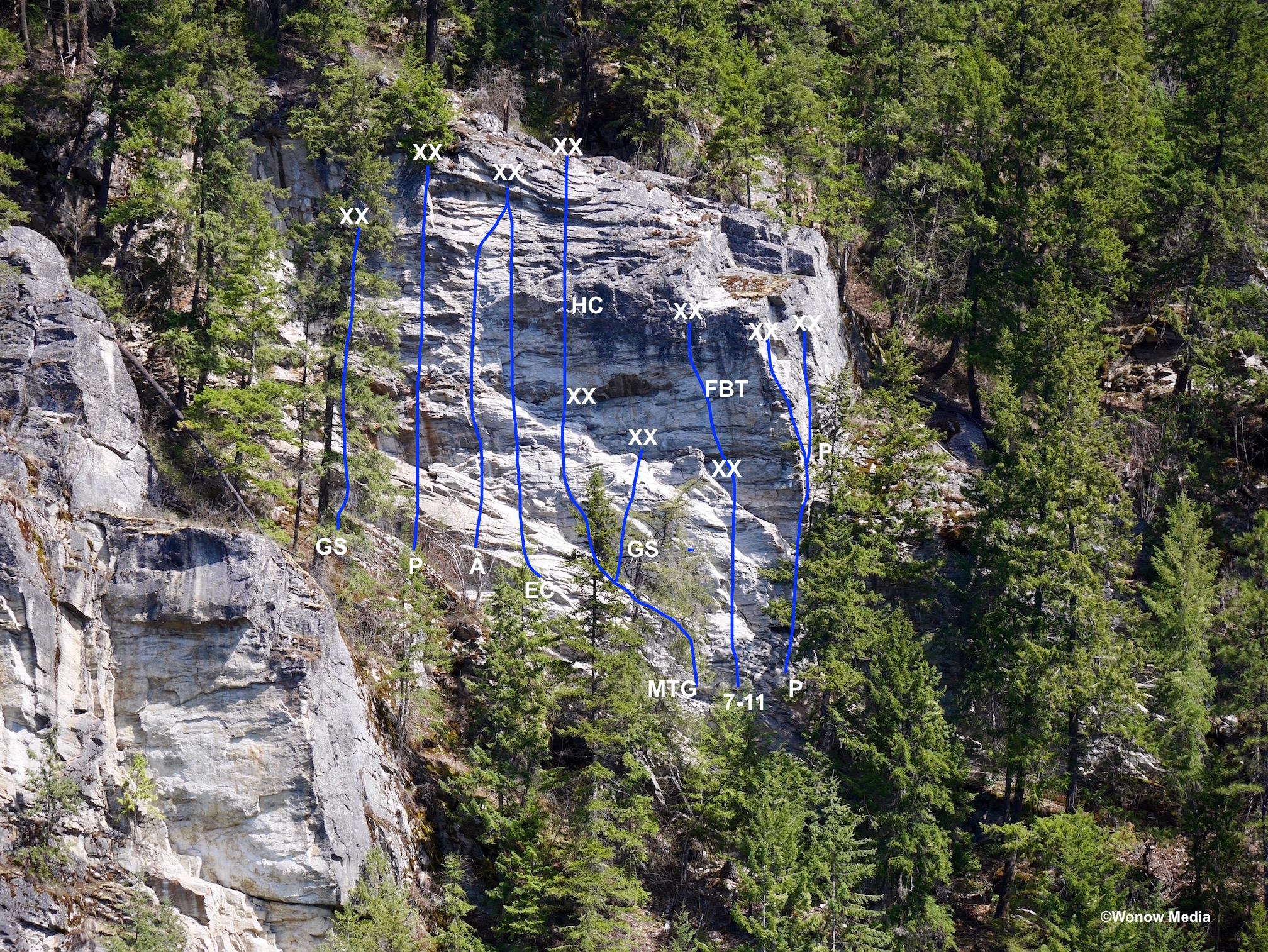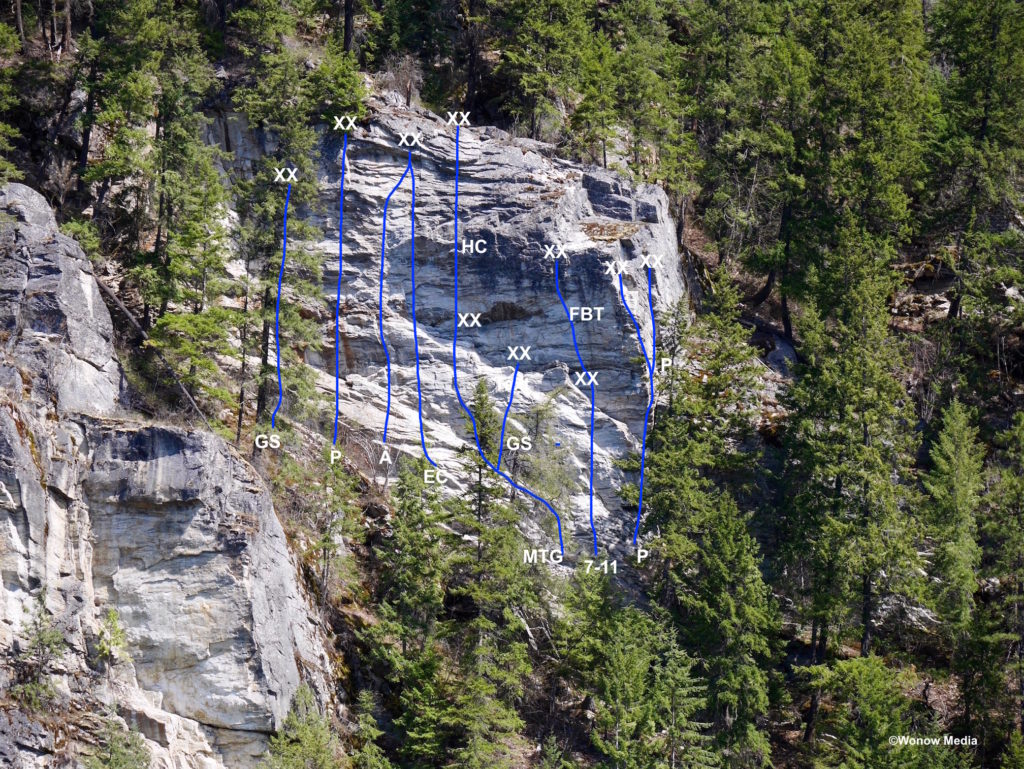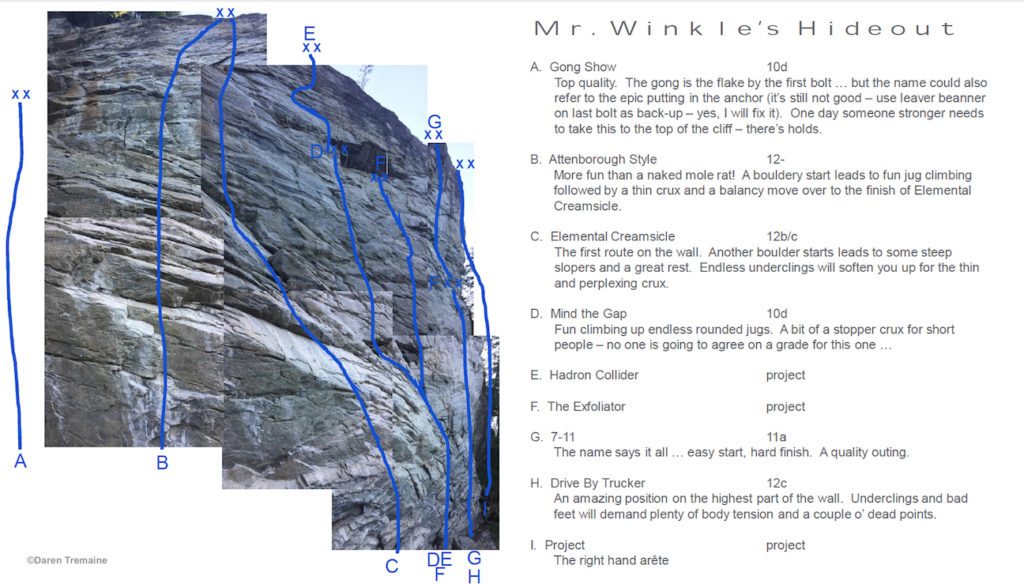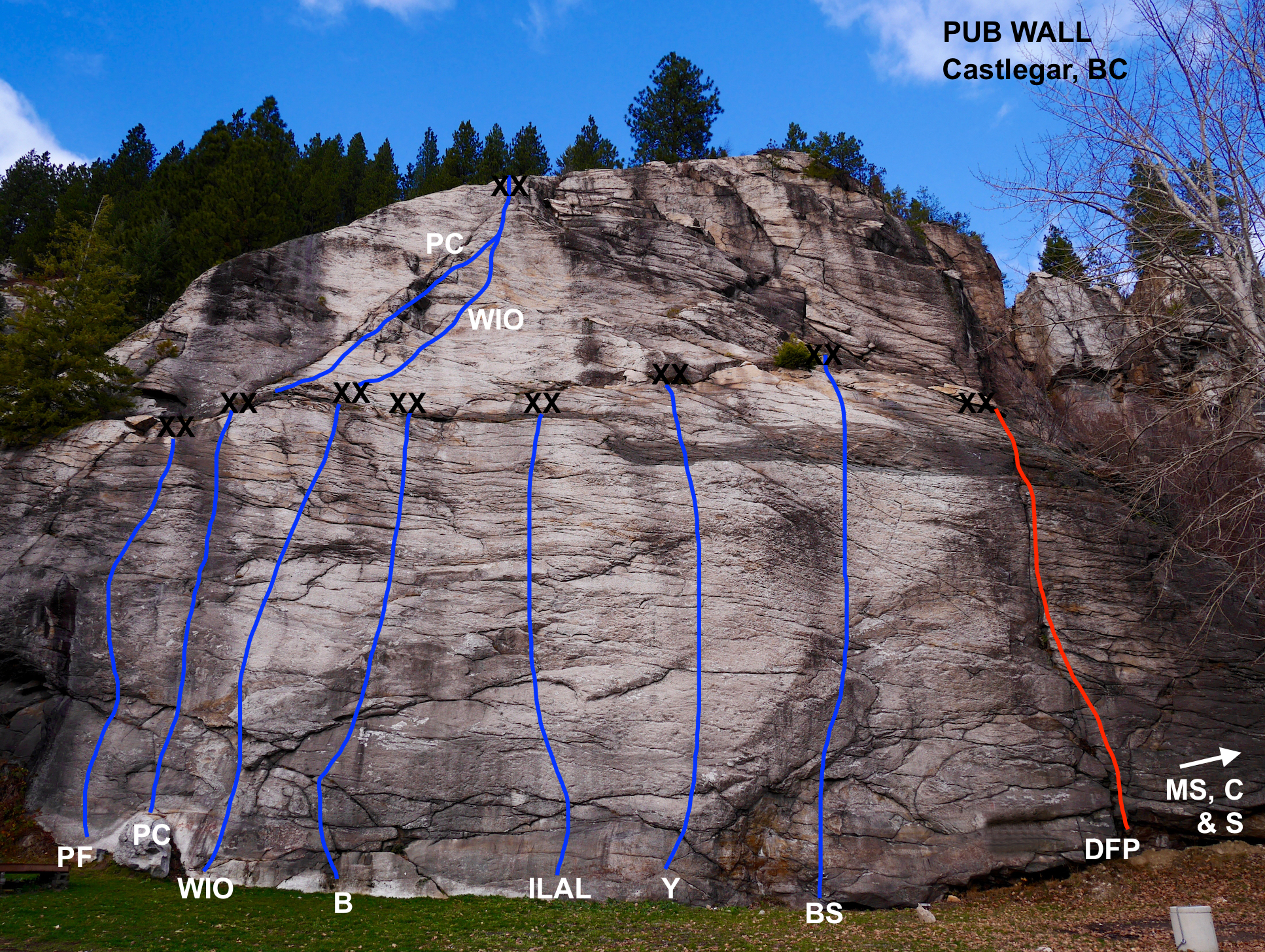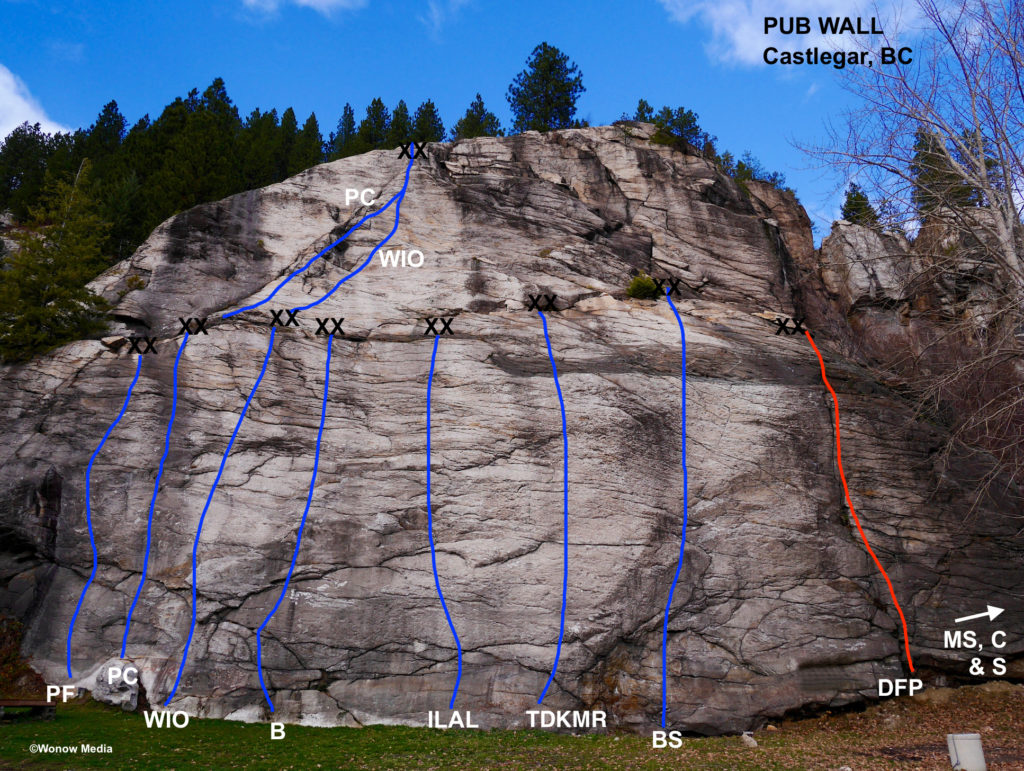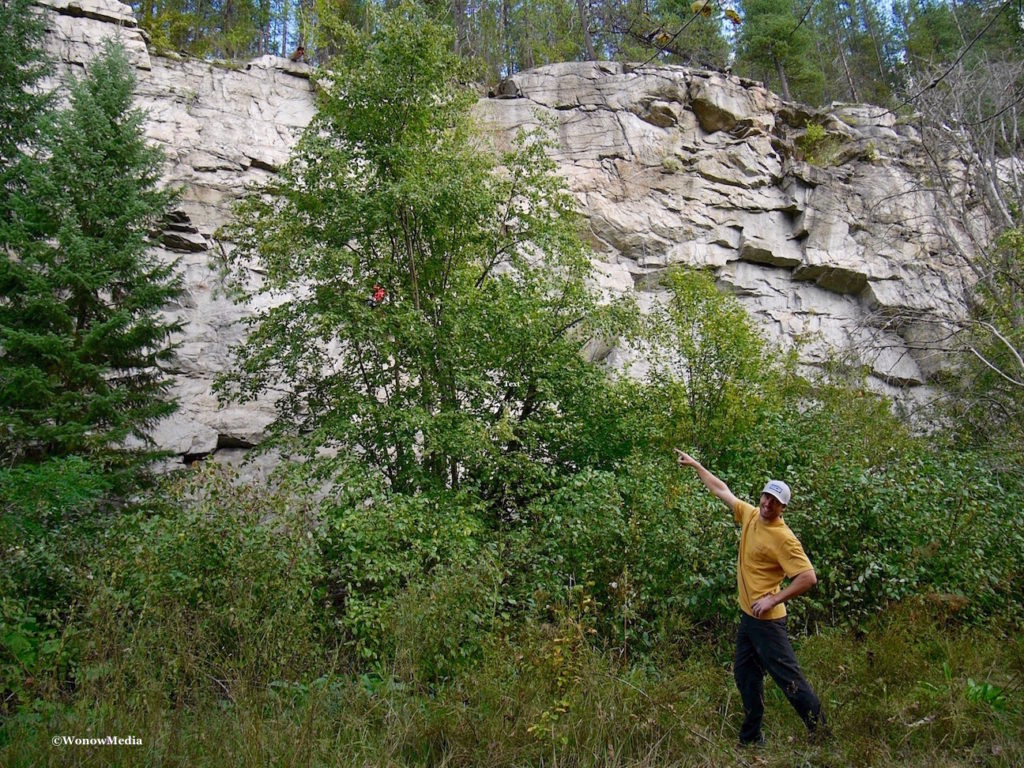
One of Canada’s best climbers, Sonnie Trotter, points to one of Canada’s best crags. Photo taken during the annual TAWKROC Rock Climbing Festival in September 2019.
Author note: Without the hard work of The Association of West Kootenay Rock Climbers, these updates would be pointless because Waterline Walls would have been lost to climbers forever. If you are not already a member, I encourage you to join. Actually, I believe it’s mandatory. If climbing at Waterline (and Kinnaird) isn’t worth a membership fee of $10 a year to you, it’s time to take up another sport. You can join at tawkroc.org. Also, big thanks to Hamish Mutch for his help with this one.
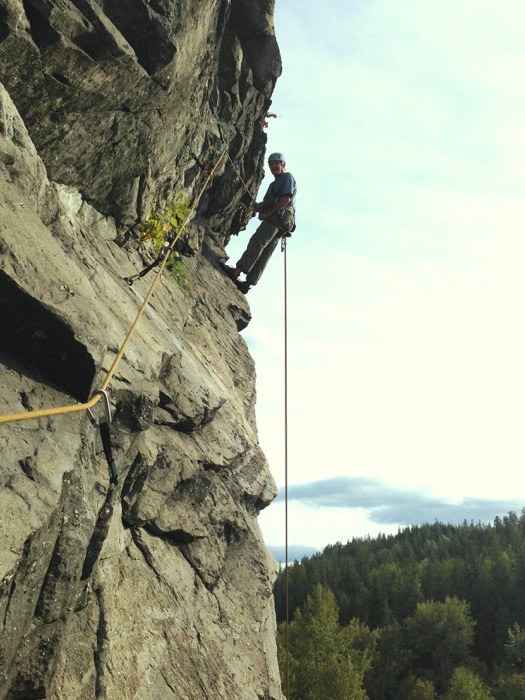
Belaying on Pool Boys, Pitch 1.
The route descriptions below are an addendum to the information found in the West Kootenay Rock Guide (WKRG). See page 47 of the Guide for access directions to this popular area, which is comprised of six different crags in close proximity to one another. Mountaineers have been practicing their rope skills on the easier terrain at these cliffs for decades but it wasn’t until 2005 that Aaron Kristiansen and some friends set about putting up the majority of the routes here. The community enjoyed 13 years of unencumbered climbing until the 80-acre swath of private property that the walls were located on went up for sale in late 2018.
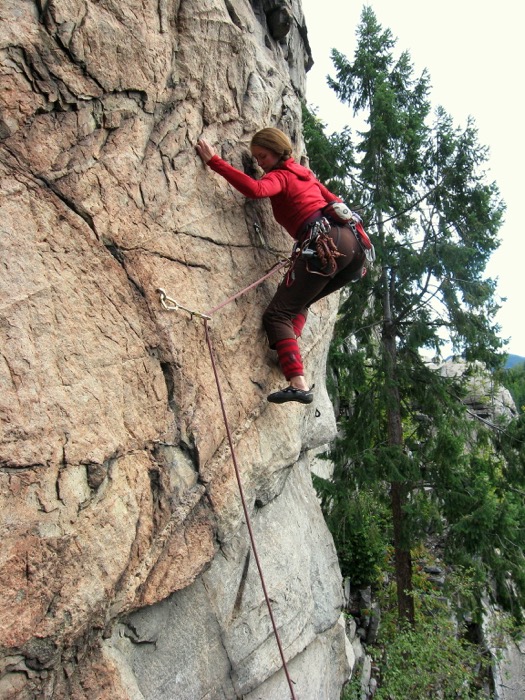
Callie walks the quartz vein. Nostalgia, Pitch 2.
A developer expressed interest but thankfully Nelson rock climbing couple Mirek Hladik and June Ray stepped in, bought the land and then got permission from the City to subdivide the portion with the cliffs. While the legal aspects of the land purchase were being negotiated, The Association of West Kootenay Rock Climbers ran a campaign to raise the $60,000 that Mirek and June were asking for the 11-acre parcel with the cliffs. Generous donations from community members, businesses, organizations and a $30,000 land acquisition grant from the Columbia Basin Trust made the purchase possible and in the summer of 2020, TAWKROC purchased the property and the “No Trespassing” signs were removed. NOTE: Although owned by a non-profit organization, Waterline Walls is still considered private property and all those wishing to recreate on the land must sign an online waiver to do so, which you can do at tawkroc.org. See the TAWKROC signs at the base of the cliffs for more information.
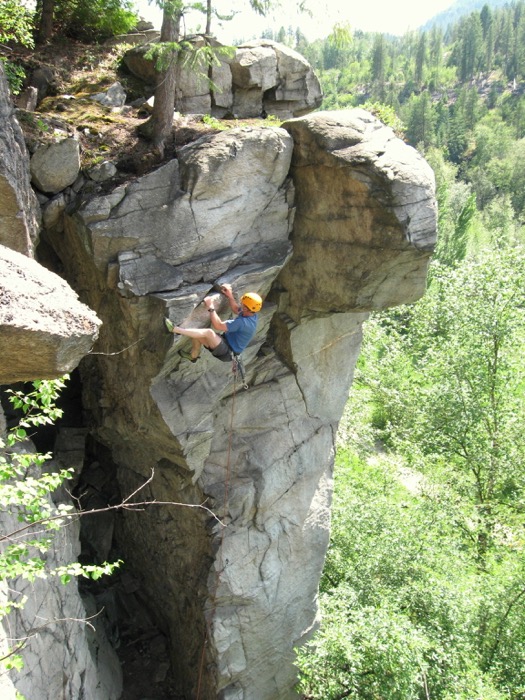
Doug tries a heel-hook. Lauryn’s Line.
Beta: This area is excellent for families as the kids have room to roam without worrying about traffic or natural hazards. Plus the approach is five to 10 minutes along a flat trail. Most anchors were retrobolted in 2019 thanks to TAWKROC, CASBC, and a monumental effort by Bob Sawyer. All walls enjoy afternoon sunshine throughout the year, however, the first three listed here are in the shade until late afternoon and so are good options during the hotter months. You can expect some mosquitos in late spring.
Gear: Most routes in these updates are sport and a 60m rope and 14 quickdraws are adequate. The exception is the mixed line Black Bird, which requires some small cams.
Access: See page 47 of the WKRG. If there are no parking spaces available on the side of 14th Ave, please park at the baseball diamond and walk in. Also, with the new development, Raven Wall has been divided into three sections (Left, Centre, and Right) for clarity.
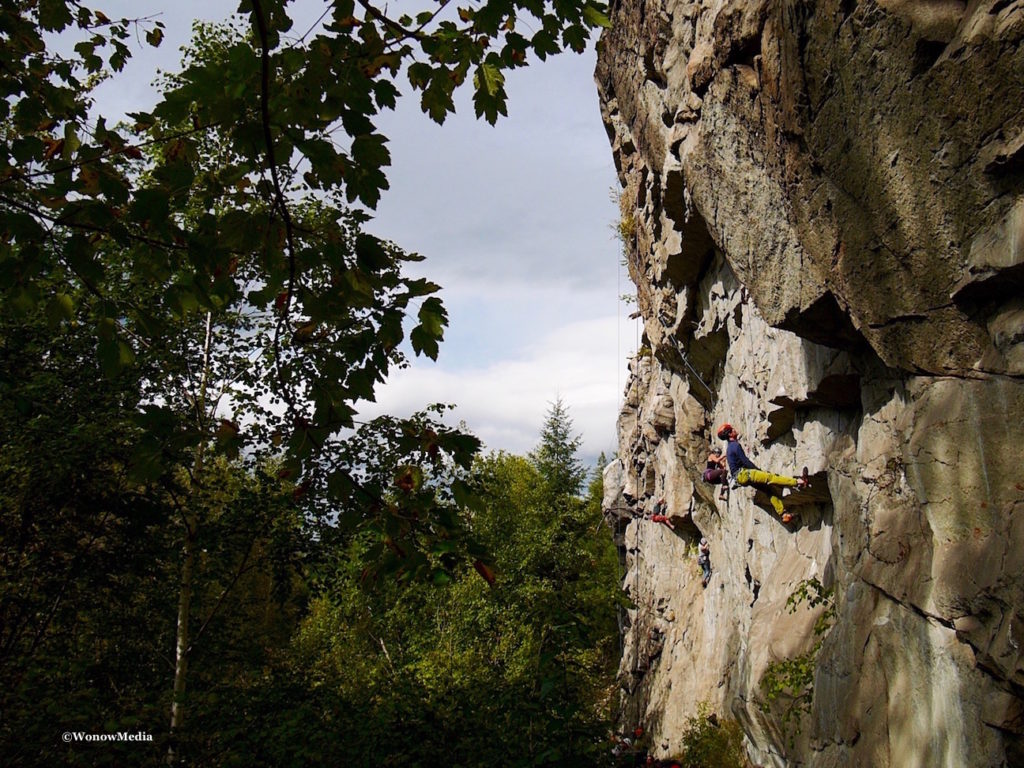
On September 22, 2019, Waterline Walls opened for one day during the TAWKROC Rock Climbing Festival Clinics. The instructors were Jasmin Caton and Sonnie Trotter and the 20 participants spent the day projecting lines on Raven Wall. It was the first time in 10 months anyone was allowed on the property since it had gone up for sale. But as of July 2020, the area has now reopened to everyone, thanks to the efforts of TAWKROC.
All routes listed in order of approach (North to South) from the car park.
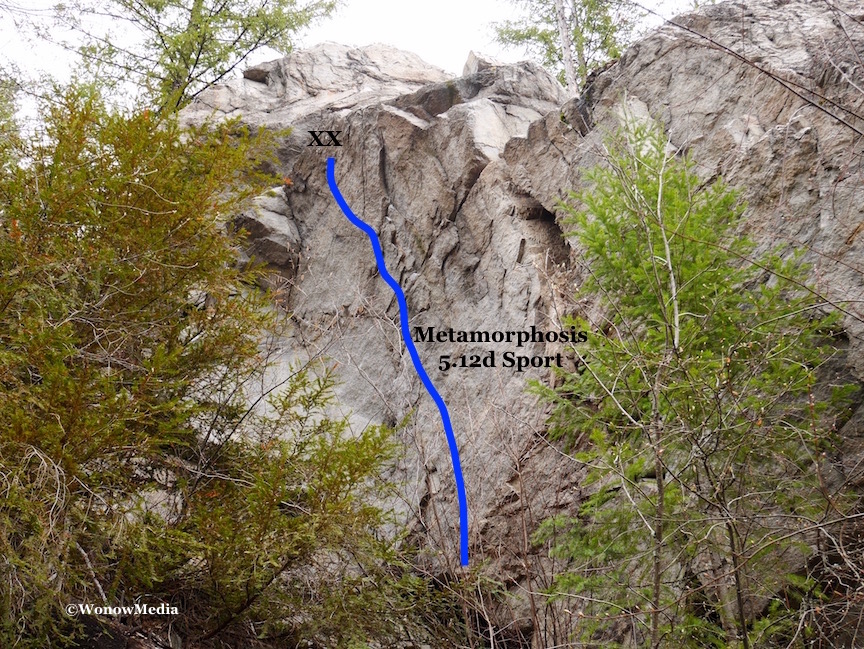
Metamorphosis 5.12d SPORT
This climb is located on a short wall between the car park and Raven Wall. (Look for the giant fallen tree on the left.) It’s a bouldery and powerful route on a gently overhanging wall that gets steeper as you climb. Dyno the finish or channel your inner gecko and use the crimps. Finishing out right eases the grade. 4 bolts. (A Fitz-Earle, M Goodrich 13)
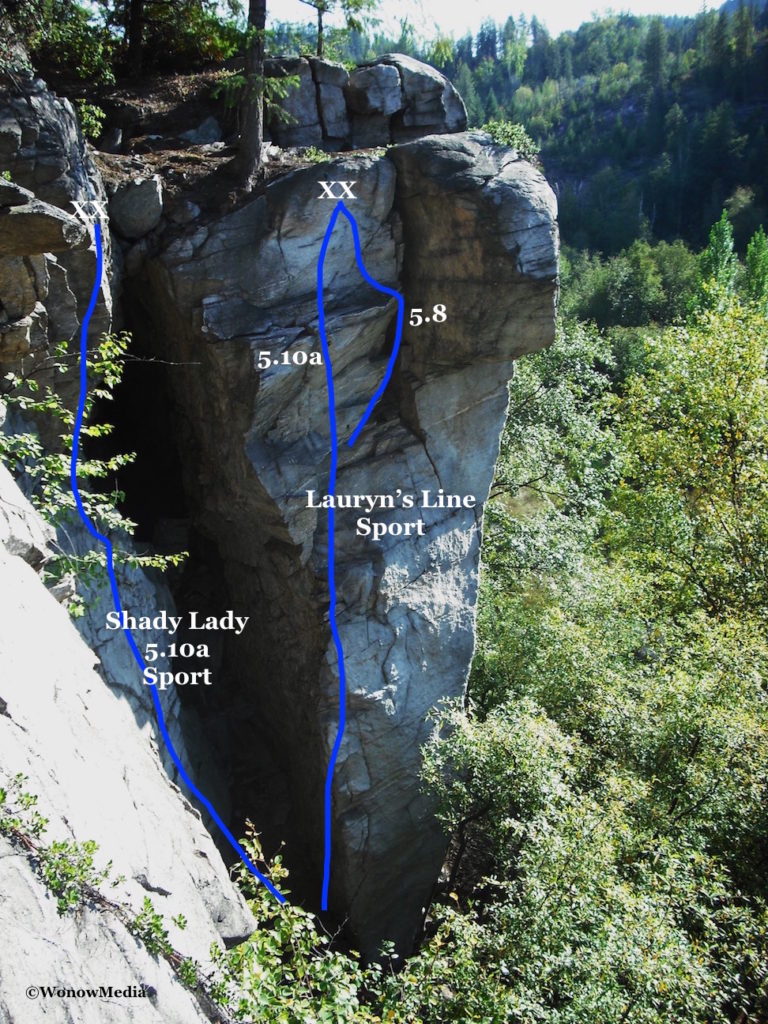
RAVEN WALL LEFT
Lauryn’s Line 5.8/5.10a SPORT
This route is located at the far left of Raven Wall above Kathryn’s Crack (P. 47 in the guidebook). Approach either by the trail that leads up from Scallywag or by starting on the old trail to the top and then cross the scree slope. The regular route has four bolts and goes from face to rib to ledge and then crack. The direct finish is 5.10a and takes you through two bulges past 5 bolts total. (K Ridge, H Mutch 09)
Shady Lady 5.10a SPORT
Starts on the other side of the gully from Lauryn’s Line. Short and steep. Finishes on some of the only chicken heads at this area. (C Chatten, H Mutch 10)
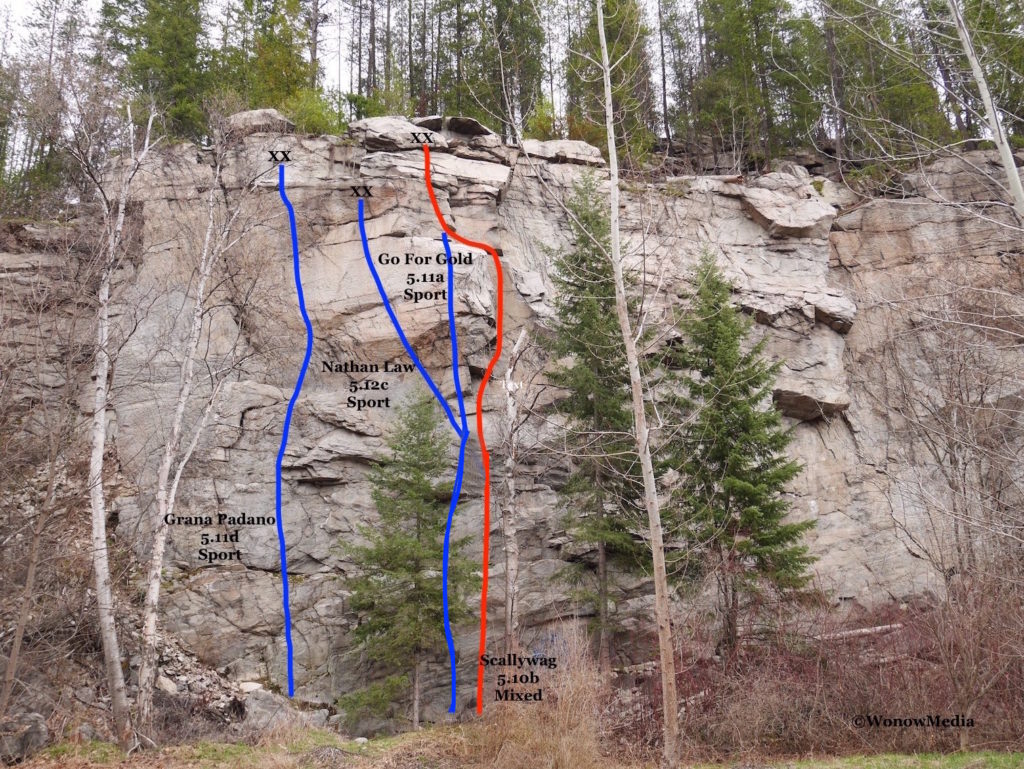
Grana Padano 5.11d SPORT
Located between Kathryn’s Crack and Nathan Law, this 20-metre, 8-bolt route is named for a popular Italian cheese that’s hard with a sharp finish. The finale is easier for you tall persone out there. (S Senecal 17)
Nathan Law 5.12c SPORT
Start a few metres left of Scallywag (P. 47) and continue left past the roof and up the overhanging face to the thin, left-leaning crack above. (FA: JT Croston, A Kristiansen 10. FFA: L Neufeld-Cumming 10)
Go for Gold 5.11a SPORT
Start as for Nathan Law but stay right and pull the small roof, then transition right to gain the steep arête. Rejoin Scallywag at the last bolt and finish on its anchor. So named because it was first climbed on the same day the Canadian men’s hockey team won the gold medal final at the 2010 Winter Olympics. (C Shute, JT Croston 10)
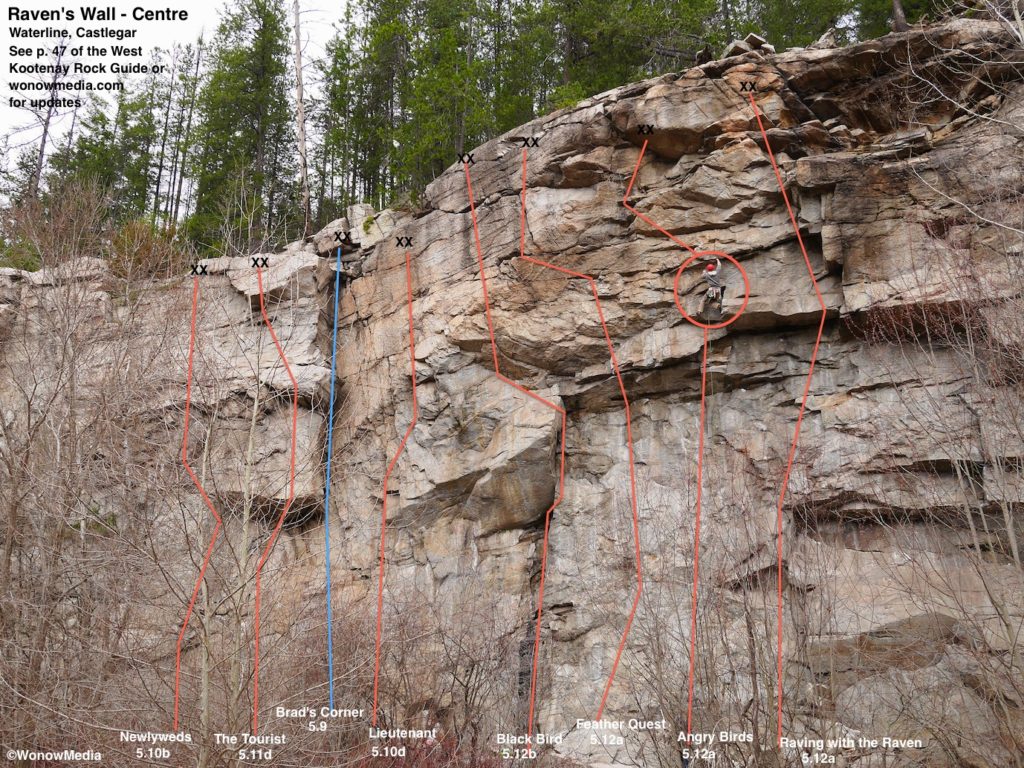
RAVEN WALL CENTRE
(See pages 48-49 in the guidebook.)
The Tourist 5.11d SPORT
In 2009 Dave Sturpin put up a line between Newly Weds and Brad’s Corner (P. 49 of WKRG). In 2013 Jesse Brown freed it and he and Keith Robine got permission to move 2 bolts to make it flow better. (J Brown 13)
Black Bird 5.12b MIXED
P. 49. This route was known as “Rattle & Hum” at one time and was listed as such in the WKRG. However, Andrew decided to change the name in keeping with the wall’s theme. The grade has also changed to accurately depict the pinky-jarring crux through the roof. Take some small cams to 1″. 27m. 7 bolts. (A Fitz-Earle, S Payne 12)
Feather Quest 5.12a SPORT
Located 3m right of Black Bird, this is one of the best and most consistent climbs at Waterline. A technical face takes you to the roof and then it’s an overhanging jug haul race against the pump. A crowbar was used on the flake by the first bolt but it wouldn’t budge. An optional small cam will protect the run-out finish through easy terrain. 26m. 7 bolts. (A Fitz-Earle, M Goodrich, S Payne 12)
Angry Birds 5.12a SPORT
Starts 2m right of FQ. Technical face climbing takes you to a crux move through the roof. Trend left and finish above the ledge with small tree. 24m. 8 bolts. (A Fitz-Earle, M Goodrich 12)
Raving with the Raven 5.12a SPORT
Starts 5m left of Super Grover. Sustained, steep climbing leads to a challenging roof and the left-facing corner above. (M Hladik, J Ray 11)
THE VALHALLA WALL
See pages 52-54 of guidebook.
Feast or Famine 5.12c MIXED
Located to the right of VPO on the overhanging arête. Start as for Carnivore. Take a few small cams for the beginning where the climbing is easier then tackle the short, bouldery crux through a small roof before it eases off on the upper arête. (M Hladik, J Ray 10)
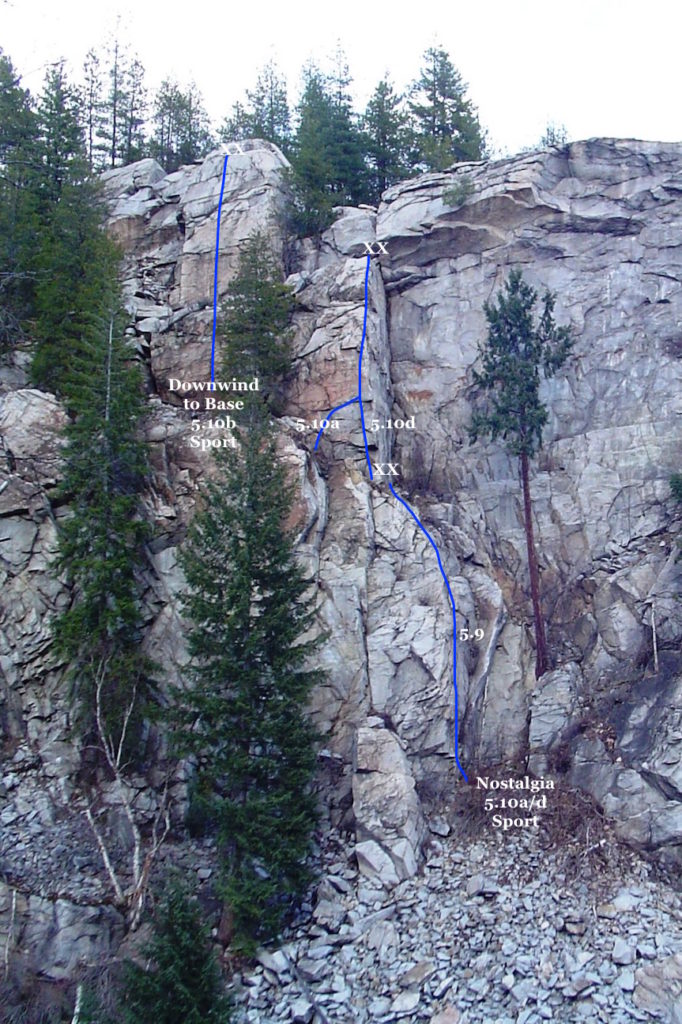
CBC Wall
See page 51 of guidebook.
Down Wind To Base 5.10b SPORT
Located on a short buttress at the top and to the left of the CBC wall. To reach it either climb Sad Goat or Nostalgia and then prepare for some thin and balancey moves. 5 bolts. (A Kristiansen 09)
Nostalgia 5.10d/10a SPORT
This climb is located on the buttress just left of CBC Wall and crosses Sad Goat in the middle. (p. 52 in the guidebook.) P1 (5.9): Follow the 6 bolts to a 2-bolt station on the half-way ledge. P2 (5.10a/d) There are 2 choices: Continue straight up the buttress, using a burly lunge/dyno move which is 5.10d, or walk 10 feet left on the ledge to a second 2-bolt station. Climb back right across the brown wall to join the direct line above the crux. (5.10a) Both take 5 or 6 clips. The route ends at the bolted station for Sad Goat. A 70m rope will have you off the route in one rap, otherwise use the mid-station. (H Mutch, A Kristiansen 09)
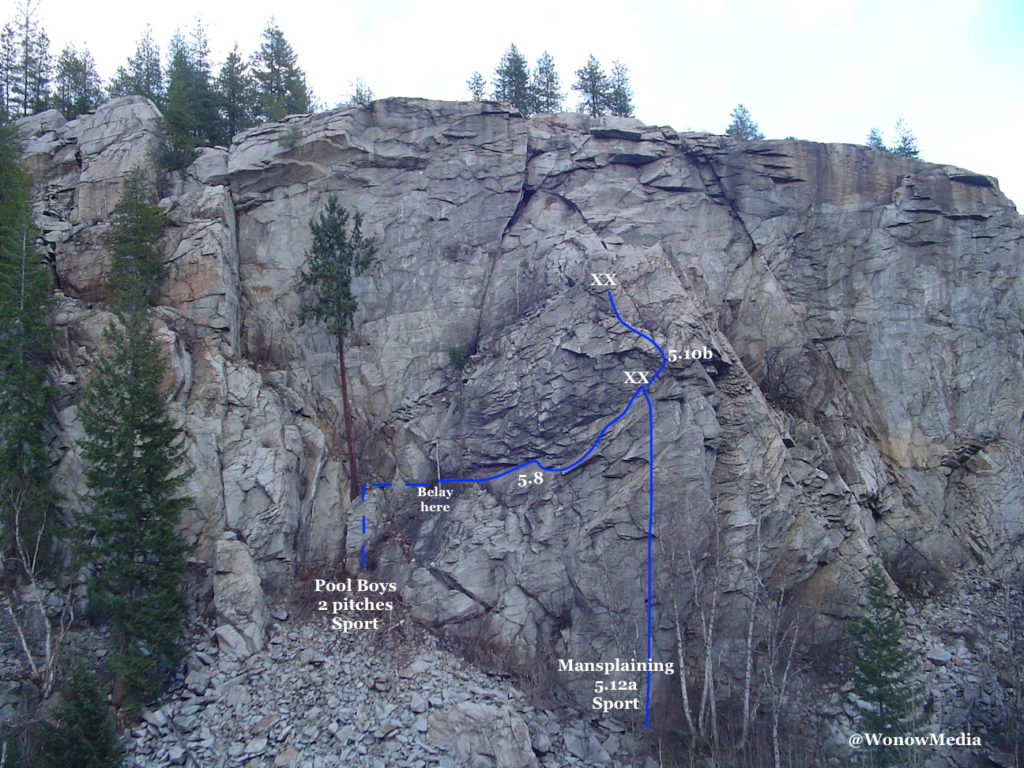
THE BIG BOULDER
See page 52 of the guidebook.
Pool Boys 5.10b SPORT
This route traverses across the Big Boulder. P1 (5.8): Start on the left side of the Boulder, halfway up the trail to the top. Belay from a few small trees, 3m left of the tall pine. Traverse right along the slab across four existing routes to the anchor below a bulge. P2 (5.10b): Strenuous moves over a steep bulge on the right lead to easier ground above. Belay from the Air Farce anchor. Rappel off V20. (M Curran, H Mutch 18)
Mansplaining 5.12a SPORT
The line of bolts located between Deep End and Deep Throat. Ends at the P1 anchor for Pool Boys. The crux is after the open book corner. 24m 10 bolts (S Senecal 18)
Nurses Wall
See page 57 of the guidebook.
Nurses Crack 5.10a TRAD
p. 57. Be aware of the big, loose block above. Finish left of the roof.
Self Awareness 5.9 TRAD
p. 57. The chains are just over the roof to the right of the last horizontal crack.
Med Error 5.11a SPORT
p. 57. A bolt now protects the upper section so there’s no need to bring gear.
Nursery Rhyme 5.10a MIXED
P 57. The start for this route has changed due to a broken hold and is now a bit harder than 5.9.
For a downloadable pdf of these updates, click here: 2020 Waterline WKRG Updates.
